
N o 63 Musicians of the Silver Screen | 08 Eurovision Goes Global | 28 Beabadoobee | 40 How Folk and Country EvolvingAre Past, Present,andFuture : N o 52 N o 71 Spring 2023 Love Songs Dissected | 11 Concept Albums | 18 The Rise of Ice Spice | 22
Get Involved
E-Board President
Angela Lin
Jess Gwardschaladse
John Buergler
Jonah Seidenfeld
Julia Towne
Nina Wilson
Phoebe Moore
Sofie Wendell
Trevor Gardemal
Want to become a Tastemaker? Click on tastemakersmag.com
Editor-in-Chief
Juliana George
Yujin Jung
get involved
Snapped some awesome photos at a concert? Email them to tastemakersphoto@gmail.com
Heard an album that really got you thinking? Send a review to tmreviews@gmail.com Get
More
Can’t get enough? Check out more original content on tastemakersmag.com
Become a fan on Facebook at facebook.com/ tastemakersmag
Follow us on Instagram: @tastemakersmag
Follow us on Twitter at twitter.com/tastemakersmag
Tastemakers Music Magazine 232 Curry Student Center 360 Huntington Ave. Boston, MA 02115 tastemakersmag@gmail.com
Chelsea Henderson
Art Directors
Jenny Chen
Megan Lam
Design Coordinator
Syd Tomasello
Promotions Director
Emily Greenberg
Photo Directors
Emily Gringorten
Kimmy Curry
Features Editor
Ethan Matthews
Reviews Editors
Henry Bova
Ananya Chaudhari
Interviews Editor
Desmond LaFave
Social Media Directors
Hannah Lowicki
Matthew Rose
Alexa Rand
Events Coordinator

Roshni Subramonian
Treasurer
Michael DeVine
Staff
Staff Writers
Ahaan Chaudhuri
Aki Gaythwaite
Alex Sumas
Alexandra Anderson
Alexandra Fu
Amy Oh
Ananya Chaudhuri
Ashley Hart
Bryana Dawkins
Cameron Alsop
Connor Briston
Dakota Castro Jarrett
Ev Ogier
Gabriel Winston-Bailey
Gabriella Trinidad
Gianna Mattessich
Hannah Lowicki
Jacob Kemp
Jayden Khatib
Justin Guthrie
Karl Adrianza
Katherine Miner
Keene Quiros
Lacie Foreht
Laurel Booth
Lillian Elwood
Lucas Cooperman
Luke Colombo
Matthew Lord
Michael Hirinda
Nora Holland
Olivia Leon
Rachel Cerato
Rilyn Szabo
Sarah Lamodi
Snehaa Ram
Terrance Dumoulin
Trevor Gardemal
Victoria Li
Wyatt DuPont
Art & Design
Alia Ziae-Mohseni
Ananya Kulkarni
Ava Ackerman
Caroline Xiong
Camille Wimpe
Catherine Terkildsen
Farah Caban
Haidyn Redmond
Jamie Tishkoff
John Nguyen
Juliana LaPara
Laura Mattingly
Maia Fernandez Baigun
Nick Alonzo
Sarah Liu
Xin Li
Promotions
Aja Binder
Alexa Rand
Bella Ramdayal
Chelsea Henderson
Desmond LaFave
Emily Greenberg
Hannah Lowicki
Hunter Chan
Jaime Adams
Jess Gwardschaladse
Julietta Siciak
Kimmy Curry
Lily Zanze
Matt Rose
Melissa Bernardin
Mica Kahn
Nadia Boudoukara
Photography
Adriana Olea
Alder Whiteford
Angela Lin
Anna Kelly
Ashlynn Braisted
Brinda Dhawan
Carol Michelle Beyda
Cayla Hoang
Charlie Bershatsky
Charlotte Hysen
Claire Adner
Elizabeth Scholl
Emily Greenberg
Emily Kobren
Emily Zakrzewski
Emma Lawson
Faith Nguyen
Genevieve Kopp
Hannah Bocian
Helen Cai
Isabella Pozzi
Jace Arrigali
James Paik
Julia Finocchiaro
Justine Tam
Kelly Thomas
Krista Brochu
Lauren Violette
Mantravadi Sairam
Matthew Rose
Max Rizzuto
Maya Solanki
Mukki Gill
Olivia Leon
Olivia Watson
Praagna Kashyap
Risa Tapanes
Rohit Gupta
Ronith Nambiar
Sebastian Wicke
Seha Khan
Sophia Seremetis
Sophie Quisenberry
Taliyah Fox
Victoria Brennick
Xander Greenway
Meet the Staff About Listening to Quote
Alexa Rand
Position Co-social Media Director
Major Music Industry
Graduating Spring 2026
Favorite Venue UBS Arena in Elmont, NY
Tastemaker Since Fall 2021
Syd Tomasello
Position Design Coordinator
Major Graphic Design and Animation
Graduating 2025
Favorite Venue The Fillmore in San Francisco, CA
Tastemaker Since Fall 2021
Jonathan Shia

Position Staff Writer
Major Biology
Graduating Spring 2023

Favorite Venue Symphony Hall
Tastemaker Since Fall 2022
Taliyah Fox
Position Photo
Major Game Art & Animation
Graduating 2025
Favorite Venue The Fillmore in Charlotte, NC
Tastemaker Since Spring 2022
Hailey Knox “AVAILABLE FOR ME”
Kehlani
“Nights Like This”
Reneé Rapp

Everything to Everyone
“She believed she could, but then took a nap instead”
The Strokes
“Razorblade ”
Paramore
“You First”
The National Sleep Well Beast
“hey guys please remember to turn in your drafts!”
NewJeans “Ditto”
Priya Ragu
“Leaf High”
Pink Pantheress
“Picture in My Mind”
“Oh yeah. That’ll do it.”
Hozier Wasteland, Baby!

The Goo Goo Dolls
“Iris”
Justin Timberlake
“Mirrors”
“my dream is to be on Matty Healy’s ‘good morning guys’”
 Modest Mouse, Terminal 5
Photo by Nick Alonzo (Architecture)
Modest Mouse, Terminal 5
Photo by Nick Alonzo (Architecture)
Cover Story
Reclaiming Folk
For decades, folk and country were seemingly exiled from popular discourse, until a few notable artists reignited the genres for the masses.
The Queer Americana: Highlighting Representation and Allyship in Country Music
While historically strained by the conservative leanings of many folk/country listeners, a few artists have made big steps in widening queer spaces in country.
Features
Love Songs Dissected
Love has remained a central theme of music for centuries, but how many iconic love songs can stand the test of time?
If It Ain’t Baroque: Classical Samples in Modern Music
While most modern musical trends have a limited time in the spotlight, one has been quietly pulling the strings backstage for decades: classical music.
A Midsummer’s Day Dream: The Sunshine Pop Sound of Late 60s California
Take a tour of an obscure genre’s surprisingly complex inspirations, journeying through a decade of west coast escapism.
Editorials
Interviews
Secular Hymns: Prayers from Prodigal Daughters
A type of songwriting often informed by trauma as much as religion, secular hymns allow artists to reshape their relationship with faith however they see fit.
Concept Albums: Telling a Story
Concept albums seem rarer than ever amidst the TikTok-ification of the music industry, but acts like Ethel Cain, Tyler, the Creator, and Lorde are keeping these important stories alive.
From MCR to MGK: The Evolution of Emo and its Subgenres
More than just a music genre, “emo” has played a vital role in the development of countless subcultures all while inspiring timeless music.
The Rise of Ice Spice
Tastemakers takes a closer look at the meteoric ascendance of the already iconic Ice Spice and her frequent backlash.
The White Lotus: Sounds of Paradise
Critically acclaimed for its dramatic, mysterious plotlines and nuanced characters, the music of The White Lotus may be even more genius.
Hyperpop: A Lesson in Collaboration
Perhaps more than any other scene, collaboration is integral to the ethos of hyperpop.
Local
Talent: Beyond the Tracks
Hear from Northeastern alum Zach Bochicchio of Beyond the Tracks about emo, their debut album, and skinny dipping.
Lil Mariko
Tastemakers recently sat down with Lil Mariko to talk about her upcoming European tour, her artistic persona, and combating stereotypes.
Album Reviews
SZA, Måneskin, Lil Yachty, Samia
Etcetera
10
Underrated Artists: Havelock
Staff writer Luke Colombo argues why indie pop artist Havelock has a unique songwriting and production style worthy of more attention.
38 45
David Bowie Discography
Take a closer look at some of the iconic rock star’s most influential work.
Taste of Nostalgia: Dark Side Of The Moon by Pink Floyd
26 28 Reviews
50 Table of Contents
11 16
46 14 36
8 18 20 22 24 42
Calendar
March
Su Sa Rockommend Chappell Roan March 1 @ The Sinclair
Roan is transforming the Sinclair into a cowgirl club for her show on March 1st, 2023.
of the rising pop star’s shows for her Naked in North America tour has its own theme, and the dress code for her Boston show is inspired by her viral single “Pink Pony Club.” Cowboy hats, rhinestones, and all things pink are encouraged for anyone attending her first headlining show in Boston! Jess Gwardschaladse (History, Culture and Law)
Chappell
Each
1 Chappell Roan The Sinclair 2 Vulvodynia Middle East 3 Pile Arts at the Armory 4 Birdbody Middle East Vanessa Carlton City Winery Jessie Murph Paradise Rock Club 5 Meet Me at the Altar Brighton Music Hall Weyes Blood Roadrunner 6 Nessa Barrett Roadrunner Curtis Waters Red Room Eliza McLamb The Sinclair 7 RUNNNER/ Waveform Rockwell 8 Colony House Paradise Rock Club Olive Klug Red Room 9 JID/Smino House of Blues 10 French Cassettes Cantab Underground Ailbhe Reddy Red Room 11 Sobs/Paper Lady Red Room ¿Téo? The Sinclair Gilbert O’Sullivan City Winery 12 Gracie Abrams House of Blues Larkin Poe Brighton Music Hall 13 John Mayer TD Garden 14 Noah in the Open Middle East Keshi Roadrunner 15 Mary Wallopers Sonia Wizkid MGM Music Hall Betty Who House of Blues 16 New Found Glory Somerville Theater Rauw Alejandro TD Garden 17 Elle Varner City Winery Hawthorne Heights Paradise Rock Club Bryce Vine House of Blues 18 Magnolia Park The Sinclair Inhaler House of Blues Mark Guiliana Red Room 19 Dropkick Murphy House of Blues 20 Tiffany Day Brighton Music Hall Bruce Springsteen TD Garden 21 Show Me the Body Paradise Rock Club Anna of the North Brighton Music Hall 22 Ezra Furman The Sinclair 23 King Tuff The Sinclair Elderbrook Royale Yung Nudy Paradise Rock Club 24 Rubblebucket Big Night Live Ibeyi Brighton Music Hall JAWNY Paradise Rock Club 25 Joshua Bassett Big Night Live Elise Trouw/ Jillian Dawn Red Room 26 Cafune Brighton Music Hall Microwave/ Oso Oso Royale 27 Chiiild The Sinclair 28 Bktherula Brighton Music Hall 29 Circa Waves The Sinclair 30 The Criticals Middle East 31 Jukebox the Ghost Royale Richard Dawson Middle East Mo Tu We Th Fr Caroline Polachek March 15 @ Roadrunner The legend behind “So Hot You’re Hurting My Feelings” will grace Boston on March 15th. Caroline Polachek is hot off her newest album release Desire, I Want To Turn Into You and is sure to put on an unreal show with flawless vocals and hypnotizing dance moves. The chance to hear “Bunny is a Rider” live at Roadrunner may be once in a lifetime. Emily Greenberg (Communications)
Slowcore veterans Duster are returning to Boston on April 14th. The San Jose natives are currently promoting their 2022 release Together Save the date and pull up to Paradise Rock Club, and if you can’t make it, stream Stratosphere <3
“Before you go”, be sure to check out Lewis Capaldi at MGM Music Hall on April 10th!! The emotionally raw Scottish singer-songwriter is currently on tour to promote his upcoming album, Broken By Desire To Be Heavenly Sent, which comes out on May 19th. We know by the end of the night, he’ll definitely be someone you loved!
April 1 G Perico Sonia Elio The Sinclair 2 RINI The Sinclair 3 Bass Drum of Death Brighton Music Hall Tennis House of Blues 4 Molchat Doma Roadrunner Maggie Lindemann The Sinclair 5 Joshua Hyslop City Winery 6 Ella Mai House of Blues Caroline Rose Royale 7 8 9 Bikini Kill Roadrunner Coco & Clair Clair The Sinclair 10 Lewis Capaldi MGM Music Hall Noah Finnce The Sinclair 11 The Academic The Sinclair 12 13 Wild Child The Sinclair Fly By Midnight Sonia Lil Wayne House of Blues 14 Duster Paradise Rock Club 15 Caroline Polachek Roadrunner 16 Spencer Sutherland Brighton Music Hall Mustard Service Sonia 17 18 Cal Scruby Sonia Rico Nasty The Sinclair 19 20 Field Guide Middle East Father John Misty Columbus Theater 21 Aly & AJ MGM Music Hall Fruit Bats Royale 22 Joywave Royale Unknown Mortal Orchestra Roadrunner 23 Black Dahlia Murder Paradise Rock Club M83 Roadrunner 24 25 Machine Girl Roadrunner 26 Valley Big Night Live Andy Shauf Royale 27 Half Alive House of Blues 28 Have a Nice Life The Sinclair Saint Motel Paradise Rock Club 29 Su Sa Mo Tu We Th Fr Duster April 14 @ Paradise Rock Club
Hannah Lowicki
Lewis Capaldi April 10 @ MGM Music Hall
(Marketing)
Alexa Rand (Music Industry)
Secular Hymns Prayers From Prodigal Daughters
Hayden Silas Anhedönia, known professionally as Ethel Cain, was raised as a Southern Baptist in North Florida and grew up singing in her church choir. She stood shoulder-to-shoulder with other children of deacons, pastors, and preachers and belted out haunting songs of praise to a god she could not see. She left the church at age 16.
In May 2022, at 24, Cain released Preacher’s Daughter, a concept album following an unfortunate runaway fleeing the Bible Belt and subsequently being killed and cannibalized by her lover. The record received universal acclaim, and Cain soon accumulated a dedicated fanbase. Although the story told in Preacher’s Daughter is essentially a gruesome Americana parable, many listeners found the spiritually-evocative lyrics and ethereal vocals reflective of their own experiences growing up Christian.
“God loves you, but not enough to save you,” Cain sings from beyond the grave in the penultimate track, “Sun Bleached Flies.”
This lyric sums up the themes explored in the rest of the record; Cain paints a portrait of a depraved and desolate America in which girls fear their fathers as much as they fear God and revere their lovers with religious fervor.
Though Cain’s time in the church choir is over, it seems she’s not done singing to God. Cain is far from the first to take inspiration from Christian worship in her music. Popular examples of secular hymns include “Hallelujah” by Leonard Cohen, “Bridge Over Troubled Water” by Simon & Garfunkel, and “Stand By Me” by Ben E. King. In the case of these more classic secular hymns, most artists included Biblical references and religious symbolism, less because of any personal connection to Christianity than because art that referenced the Bible was considered profound at the time. Now, a new generation of formerly Christian, often queer indie icons are redefining the genre.
Lucy Dacus and Julien Baker, two-thirds of the budding indie supergroup boygenius, also both grew up Christian in the Bible Belt. Dacus has since left the faith, and Baker declines to publicly define her beliefs, but in both cases, their religious upbringings have undoubtedly had an indelible impact on their musical stylings.
Dacus’ third studio album Home Video dropped during the sticky, lethargic summer of 2021, featuring more intimate storytelling than any of her previous work. Redolent with
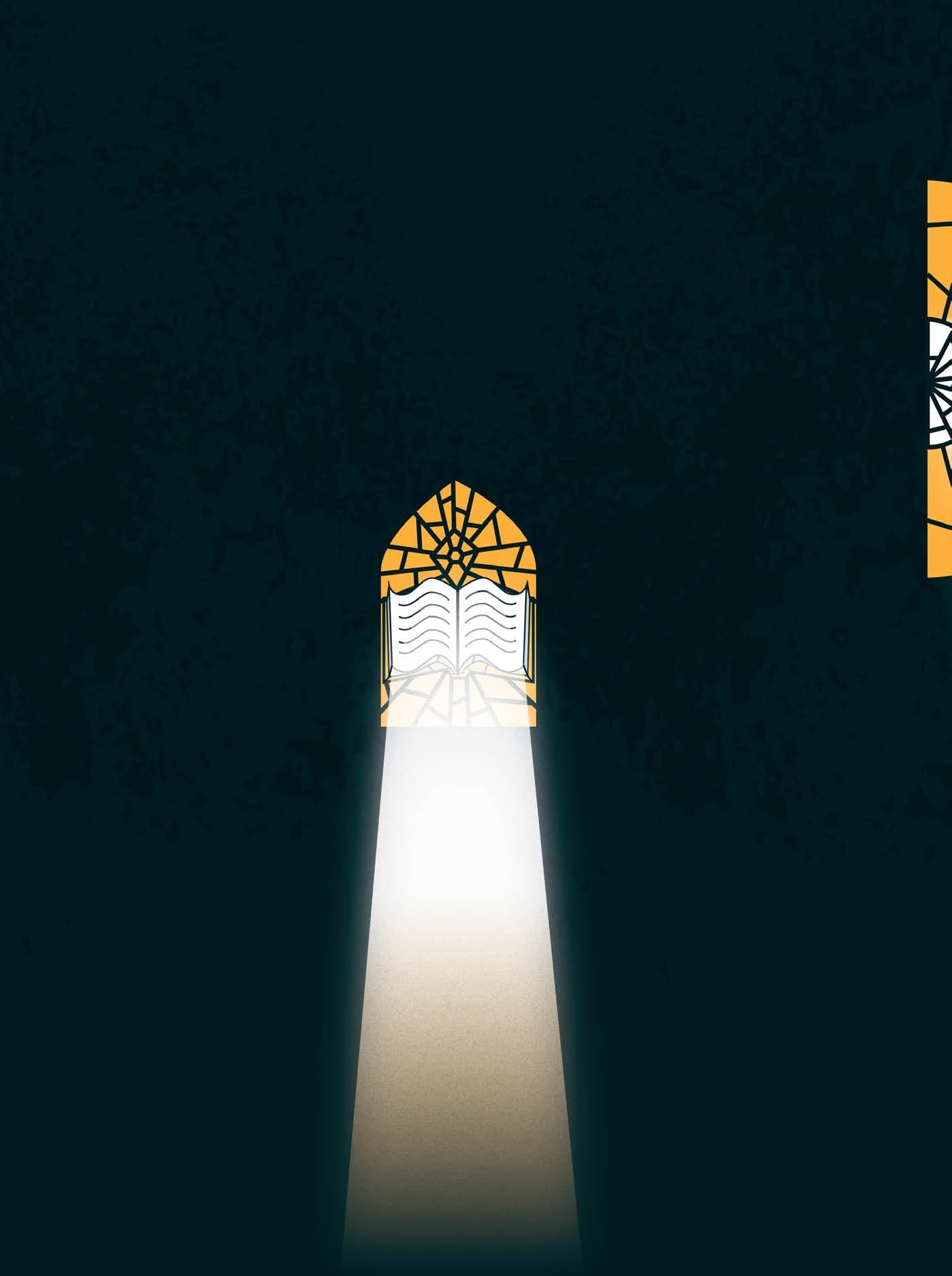
Spring 2023 Editorial 8
nostalgia and yearning, the record masterfully captured the moments Dacus’s faith came into direct conflict with her sexuality and values. Tracks like “VBS” and “Christine” were the most explicitly revealing of the hypocrisy Dacus noticed within the church, as expressed in lines like “In the summer of ‘07 I was sure I’d go to heaven / But I was hedging my bets on VBS” and “We’re coming home from a sermon / Saying how bent and evil we are.” However, the undercurrent of repressed longing running throughout the album combined with Dacus’s mellow vocals brings to mind both the experience of leaving the faith and the sound of the songs she would have grown up singing in church.
Although Baker has her own share of religious trauma, having navigated faith as a queer woman in suburban Tennessee, her music more often invokes God as a means of exploring other ideas, like her struggles with addiction and mental illness. In “Rejoice,” the penultimate track on her debut album Sprained Ankle, she sings, “But I think there’s a God and he hears either way / I rejoice and complain,” to lament her feeling of abandonment by an indifferent God. In “Faith Healer,” from her 2021 album Little Oblivions, she
compares the feeling of relapsing to being touched by a spiritual healer, in that both situations only offer temporary relief. Despite these distinct critiques of Christianity, Baker continues to hold onto her faith, and incorporating lyrics and musical elements of worship into her work is a trademark she’s not likely to let go of.
Natalie Mering, professionally known as Weyes Blood, also possesses a transcendent, soaring sound reminiscent of a church choir, but Mering’s hymns are more suggestive of the Rapture than of the personal spiritual reckonings examined by the former artists. Raised as a born again Pentecostal Christian, Mering left the faith at a young age, taking with her a strong sense of spiritual purpose and an affinity for otherworldly soundscapes. The musician has long imbued her work with a sense of post-apocalyptic modern dread, but in her latest album And in the Darkness, Hearts Aglow, she draws upon the mass disillusionment of listeners during the pandemic to craft a divine commentary on the ills of contemporary life. The lead single “It’s Not Just Me, It’s Everybody” and subsequent track “The Worst Is Done” dissect the loneliness and pessimism prominent in
so many lives the past couple of years. Even less universal songs like “Grapevine” and “A Given Thing” communicate the alienation symptomatic of the consumer culture Mering believes has replaced religion. For Mering, secular hymns are both plaintive prayers to the universe and an invitation for listeners to sing out their sorrows alongside her in imaginary pews.
It’s no revelation that musicians are inspired by the music they grew up with. However, secular hymns are unique in that they allow artists to reshape their relationship with faith however they see fit — through Biblical themes, powerfully beseeching vocals, or flat-out excerpts from childhood diaries. Thousands of people who have been burned by Christianity in one way or another can find comfort and catharsis in hearing their experiences represented, and former Christians don’t have to throw their nostalgia for worship music out with the bathwater. When belief systems change, art shouldn’t have to. In fact, it’s all the better for it.
Designer: Larua Mattingly (Communications & Design)
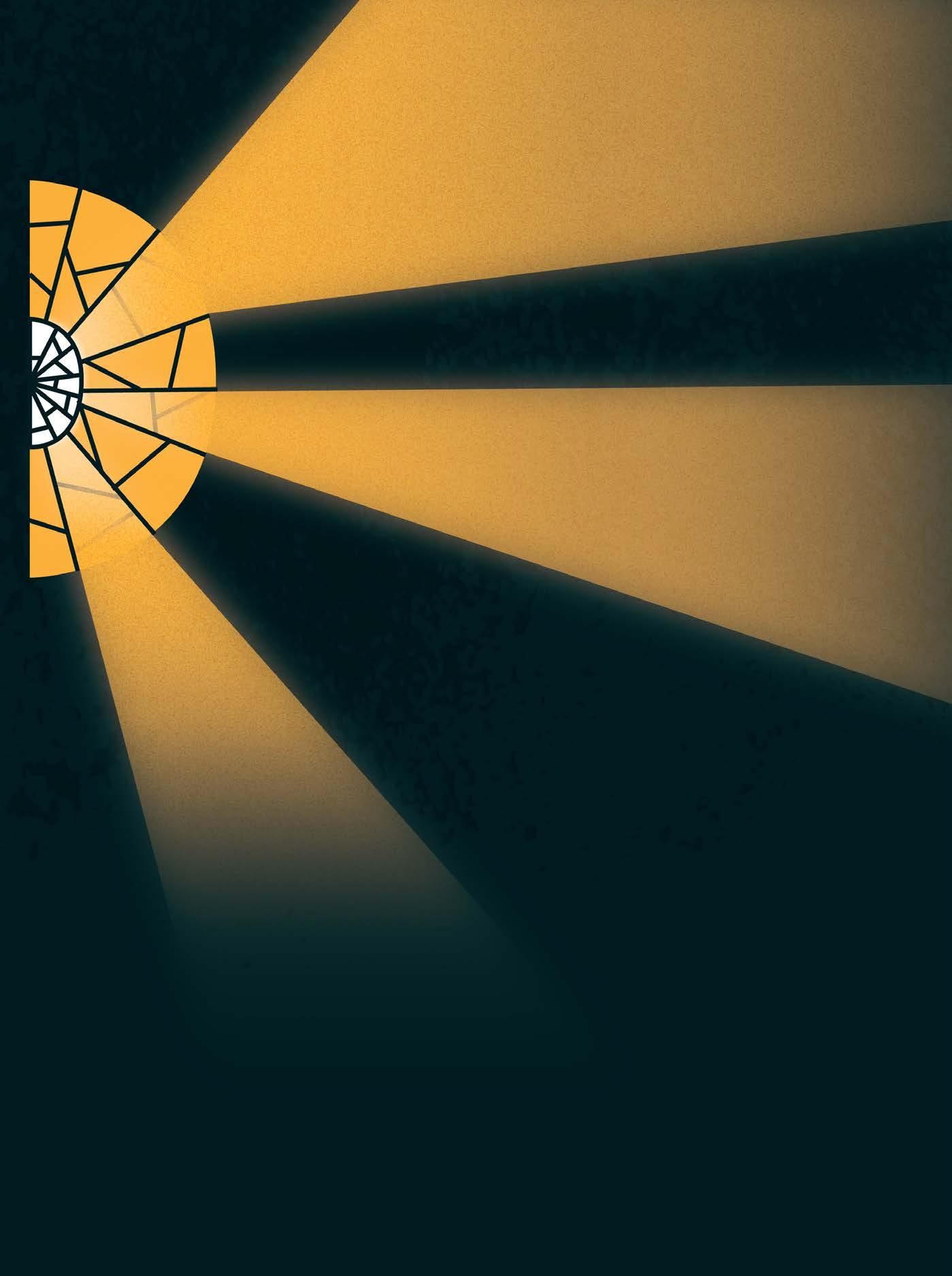
• Juliana George (Journalism & Sociology) 9
Designer: Alia Ziae-Mohseni (Computer Science and Design)


I didn’t think much of Havelock’s single “Scrambled” when I first found it on one of many Spotify playlists advertising fresh indie tunes, bedroom pop, and the like. It had a neat chord progression and interesting production, and wound up in my walking playlist where I heard it a few times on the way to school. A year later, during my semester in London, I saw a concert ad for Havelock online — I only noticed it because I’d heard that one song. Only 7 pounds for a concert? My friends and I were sold.
We weren’t expecting a lot from this unknown artist who looks like every other British man – I swear I walked by him about ten times on my way there – but it turned out to be a ton of fun. He’s local to central London, and the crowd was dancing and shouting every word. The small venue had no fancy equipment, but his performance was great, and I was struck by how diverse his songs were, for a small pop artist. After the show, I listened to his entire (short) discography, and became a fan.
Havelock has a roughly indie pop sound, akin to Still Woozy or Roy Blair, and his songs generally contain smooth vocals on top of synthesized, drum-driven beats. However, his music is a departure from the bedroom pop wave of a few years back — what hooked me the most was his unique songwriting and production. Havelock starts his debut EP TRY B4U BUY with a strange assortment of sounds — dark sounding piano chords, aggressive background vocals, woodwinds — on top of a syncopated drum beat. The rest of the tracks continue playing with instrumentation, combining drum machines, percussion, horns, guitar, and bass. He often experiments with song structure, using lots of beat switches and breakdowns, which can feel slightly chaotic, but his music remains catchy, easygoing, and pop sounding.
His earlier singles can be a little rough around the edges, but looking at his two EPs, it’s impossible to miss Havelock’s potential as an artist. The vocals and melodies on TRY B4U BUY are certainly
a step up from earlier works, featuring a more refined, composed sound. The track “CHINA DOLL” has very mature songwriting and lyrics about struggling to comfort a partner dealing with personal issues. On “Pheromones,” Havelock throws out his approach of beat switches and vocal effects in favor of a simple house beat that’s infectiously catchy and chill at the same time.
Havelock’s vocal performance is great live, but he also captures his energetic, slightly eccentric swagger in his recorded music. I like his personal blend of singing and rapping shown on “London’s Burning,” and his diversity in vocals is a theme throughout his discography. Like his songwriting, Havelock’s lyricism feels like a step above similar sounding artists, particularly on “London’s Burning,” as well as perhaps my favorite song from him, “Real.” While many of his songs are about standard topics like pursuing a lover or dancing at a club, these two also tackle issues of overwork culture and finding meaning in the hustle and bustle of a major city. “Real” has catchy melodies over an energetic, vaguely hip-hop beat, but the lyrics clearly attack modern consumerist ideology that values appearance and material possessions over honest, meaningful relationships.
Some tracks from Havelock’s last EP, The Idols of a City Dweller, fall a little flat, trading the unique elements of his brand in favor of a more basic pop sound. Despite this, I think his music is very promising — even nowadays, where it’s common to find indie artists with a polished, professional sound, Havelock’s songwriting and performance prowess makes him stand out from the crowd. I admit the term “genreless” can be a little overused, but he truly does fall into the space between pop, indie, and hip-hop, and has something for fans of each genre. Though he only has about twenty songs right now, Havelock’s sound certainly has potential, and I will be looking forward to any future projects.
Spring 2023 Etcetera 10
• Luke Colombo (Computer Science and Cognitive Psychology)
It’s no secret that love is one of the greatest mysteries of life. It has started wars, shaped history, and inspired artists throughout time. Some of the greatest stories in human history hinge on this intangible feeling: the desire to put another before yourself. Whether or not humans understand (or will ever understand!) love, it has remained a central theme of music and all art forms throughout the decades.
However, even though this underlying emotion may seem unwavering against the tests of time, relationship standards and outlooks on gender roles are constantly changing. Mainstream media has historically excluded queerness from the spotlight, making most “iconic” love songs revolve around heterosexual relationships. When dissecting gender norms and its impacts on evolving media, it’s important to note that men have historically maintained greater autonomy and notoriety. Because of this, this article’s comparative analysis intentionally explores songs exclusively written by men. So, what does this mean for iconic love songs? Is it possible that 60-year-old songs could still be relevant today? Are these declarations of love still valid even when based in sexist and antiquated values?


11
“Can’t Help Falling in Love”
by Elvis Presley (1961)
Arguably one of the most recognizable love songs of all time, “Can’t Help Falling in Love” by Elvis Presley has initiated endless covers, including UB40, U2, Pearl Jam, Twenty One Pilots, and plenty more. In fact, this song seems to never lose its notoriety, with Kacey Musgraves releasing the most recent iteration in 2022 for the Oscar nominated film, “Elvis.” Almost everyone knows this song, a true staple of its illustriousness.
But other than its sheer popularity, what makes it a stand out love song? Part of it must be rooted in the historical context of the second-wave feminism movement of the 1960s and 70s, which extended beyond legal rights and considered issues of personal freedom and sexuality. The sentimentality of this song ties in with this cultural shift by making no reference to gender norms, the “expected” role of women, or artificial or physical attributes. As the song goes, “Take my hand / Take my whole life too / For I can’t help falling in love with you.” With an attitude so pure and so romantic, this love song strips away the noise to get to the root of an indescribable feeling, using few words to describe so much.
With no sexist undertones, pure intentions, and a track record of replicability, it’s safe to say that “Can’t Help Falling in Love” has made its mark. And it’s here to stay.
“More Than a Woman” by Bee Gees (1977)
Fast forward a decade and then some, and Bee Gees have written “More Than a Woman’’ for the movie “Saturday Night Fever.” Dissecting the creation of this song is important to understand its relevance and longevity. “Saturday Night Fever” brought disco music to the main stage while discussing themes of sexual promiscuity, disco culture, and escapism. Although these concepts seem in line with contemporary values of progressiveness and the liberation of women, the mentions of nonconsensual advances towards women, lack of bodily autonomy, and objectification grounds this song in the reality of previous sexism. Although the second-wave feminism movement continued throughout the 1970s, it clearly was not present in this film.
However, “More Than a Woman” is an inarguable bop. Barry Gibb’s falsetto paired with groovy background percussion adds a
distinct disco sound, and the memorable keyboard riffs keep listeners intrigued. The lyrics, however, point towards an earlier point in history. The repeated sentiment of “more than a woman to me” may seem progressive from a modern day lens, especially in a time of defeating gender norms and reimagining gender identities, but when rooted in this historical context, the track’s title seems demeaning. Is being a woman not enough? Does one need to exceed the imposed expectations of being a woman to be worthy of love? Is it even possible to step outside of this box of womanhood without facing the repercussions of the time’s sexism?
With this context, it’s unclear how pure the writers’ “love” really is for the song’s recipient. Although lyrics like “If I lose you your love, I know I would die” and “I know that in a thousand years / I’d fall in love with you again” convey a level of devotion, it’s still unclear if it’s unconditional. It’s easy to adore someone within the confines of previous expectations. But what happens in a thousand years when this woman no longer conforms to 70s gender norms?
Without the historical and film context of the famed song, “More Than a Woman” has certainly retained its popularity. However, if one is truly reflecting on its original sentiments, this song is rooted in antiquated values.
by Fleetwood Mac (1987)
It’s fitting that the only track to come from a mixed-gender group is from a band known for its tumultuous internal love stories: Fleetwood Mac. Tango in the Night was released 10 years after the famed Rumours album, and being the last studio album that the legendary 70s group would complete together, includes a farewell love song that has proven its longevity. Turning away from the storyline of the band itself, “Everywhere” is a sentimental and sneakily androgynous track. With no mention of gender identity, sexuality, or even who the intended singer/audience is, “Everywhere” has a simple message: “I want to be with you everywhere.”
When paired with the fantastical sounds of the track, this message becomes more significant. On “Everywhere,” Lindsey Buckingham experimented with new techniques by using a 1970s sampling synthesizer, a new piece of technology for the artist and his bandmates. By playing tapes back at varying speeds while recording, this track and album have a distinctly different production sound than Fleetwood Mac’s previous releases. This innovation supplements backing vocals and verses at unexpected moments, creating moments of euphoria. Although the lyrics may be repetitive and straightforward in nature, Buckingham’s additions make it clear that there’s nothing simple about feelings of love.
Leaving behind the social attitudes of consumerism and rising feminist movements like difference feminism, “Everywhere” is powerful in its dichotomy. Whereas equality and difference feminism attempted to argue for women’s rights by highlighting the similarities and differences between men and women, Fleetwood Mac surpasses barriers to either argument. By deliberately not grounding itself in gender, “Everywhere” transcends constraints of time to make a track that mirrors the mystery of love itself.
“Everywhere”
Spring 2023 Feature 12
“I Don’t Want to Miss a Thing” by Aerosmith (1998)
As shocking as it may seem, one of the most unforgettable love songs of the 1990s comes from “the Bad Boys from Boston.” This power ballad — written by Diane Warren — was originally intended for an artist such as Celine Dion; no one could have anticipated the version that this hard rock band would perform for the 1998 film “Armageddon” when Steven Tyler’s daughter, Liv, was cast.
This track is unique in comparison to others as it describes a different type of love: fatherly love. In “Armageddon,” the plot revolves around a father flying onto an asteroid to drop a nuclear bomb and save Earth. His daughter (played by Liv Tyler) is left behind on Earth as he and fiancé go on the lifesaving mission. The movie ends with the father sacrificing himself to detonate the bomb, allowing his daughter and fiancé to reunite — a true father-putting-his-daughterfirst moment. “I Don’t Want to Miss a Thing” is the theme song for this film, and its lyrics reflect this paternal selflessness.
The lyrics of this song could be seen as romantic, but when viewed through the lens of a father to their child, it means more. When lines like “Every moment spent with you is a moment I treasure” and “Cause even when I dream of you / The sweetest dream will never do / I’d still miss you baby / And I don’t want to miss a thing” become associated with a bond stronger than typical romantic love, their value becomes enshrined in history. The connections of Steven and Liv Tyler along with the father-daughter storyline of “Armageddon” makes this more than a love song — it’s innate love. “I Don’t Want to Miss a Thing” arose from a surprising series of events; not only is a power ballad out of character for Aerosmith, but soundtracking a movie was also a first for the band. We should be so grateful for the circumstances and fatherly dedication between Tyler and his daughter that bred such a timeless piece of music.
“Yellow” by Coldplay (2000)
With early 2000s pop music fragmenting into nondescript, new genres, it’s no surprise that “Yellow” has a unique sound compared to others on this list. Coldplay, commonly described as an alternative pop rock band, released “Yellow” on their debut album Parachutes in 2000. Lead singer, Chris Martin, has continuously spoken about the creation and intention behind one of the band’s most popular tracks. Although the title and theme of ‘yellow’ is told as a coincidence, Martin links the symbolism of the color to the attitude of the band when the song was written: “filled with brightness and hope and devotion.” Coldplay is still touring together and performing this song globally 23 years later, proving that the love between the band members is as long lasting as the love described in the track. It’s not surprising that this song’s longevity is as strong as the friendship that inspired it.
Besides the background to the track, “Yellow” has retained its popularity and value. Jonny Buckland’s opening electric guitar riff, when paired with Martin’s acoustic guitar, creates a sound that has only become more recognizable with time. Notable lyrics include: “Look at the stars, look how they shine for you / And everything you do” and “For you, I’d bleed myself dry.” Martin himself has commented on how the lyrics in totality don’t make sense, but then again, neither does love. Attempting to unravel the mystery of love is the motivator behind art in so many different forms; there would be nothing beautiful left to create if we already understood it.
“Yellow” is not only iconic for its impact on Coldplay’s career and unique sound, but for the warmth it conveys. Martin’s intonation in the lines of “And it was all yellow” adds a depth to the simple words and creates a song that is forlorn in nature. When combined with the intrinsic associations of the color yellow, Coldplay creates a love song that isn’t dependent on passion. Much like its name, listeners can understand the pure love depicted through its lyrics as well as the emotions that come from the attitude of the band. “Yellow” doesn’t depend on grand gestures of affection or identification of the love interest to distinguish itself as an iconic love song.
“All of Me”
by John Legend (2013)
The legacy of love songs reaches modern day with the track that still plagues 2010s radio stations: “All of Me” by John Legend. Even if you aren’t a fan of this era or style of music, I’m sure these lyrics live rent-free in your head. Legend wasn’t always a legend, but this number one hit brought his artistry to center stage. This ballad, including only his vocals and piano, is the epitome of a love song: sincere lyrics composed for only one listener.
Intended for Legend’s now wife, Chrissy Teigen, the lyrics of “All of Me” hinge off of opposites. With direct contrasting pairs such as curves and edges, end and beginning, lose and win, Legend shows that even through differences and imperfections, someone can love another in their entirety. The fact that the only instrument on this track is the piano supplements his message as it allows the sweetness of the lyrics to be the one and only focus. Creating a song that dedicates one’s entire being to another eases any fear or insecurity about the deepest parts of oneself. It’s safe to say that this may be one of the most romantic sentiments of all of the songs explored.
It’s only been 10 years since this song was released, and without relying on mentions of society, current culture, or gender norms, “All of Me” will undoubtedly continue to stand the test of time.
Love songs aren’t going anywhere. Whatever your relationship status might be, these iconic tracks hit a chord deep within our human nature. Artists will continue to dissect this indescribable feeling, as they have for centuries, but how we choose to express these feelings will certainly continue to evolve. Through exploring androgyny, warmth, or familial love, many of these songs show that the heart of lyrics can stand the test of time when drawing off of pure intentions and personal experiences. It’s when songs are correlated with the culture of their time that their essence becomes blurred to changing social standards and growth. But one thing is for sure: we’ll continue to sing about love forever.
• Rachel Cerato (International Affairs and Environmental Studies)
13
Designer: Haidyn Redmond ( Business and Graphic Design )
• Local Talent
In early January, Nashville-based emo band Beyond the Tracks released their debut album, A Path is a Circle. While Zack Bochicchio, Northeastern alum and lead vocalist, started the band on his own, the album features Sam Chassy on bass and Sam Roth on drums. Beyond the Tracks released their first single in 2019, while Zack was still at Northeastern, and much of the source material pulls from his time in Boston.
Tastemakers recently spoke with Zach about working with Sidney Gish, writing about friendship, and recording with Modern Baseball.
Tastemakers Magazine (TMM): You’ve got a couple tracks on the record that have aspects of friendship in it. Is that one of the central pillars of this project? I know that this album has been a long time in the making, so how have friendships played into that?
Zack Bochicchio (ZB): I wouldn’t necessarily say friendship is a particular pillar, but both “Cannibalize Me” and “Sud Summer” deal with friendship and relating to people. “Cannibalize Me” is much more about the intense loneliness that I had when first moving to Nashville. I didn’t know anyone and it was the middle of a pandemic, so those brief moments of being able to socialize with people were so important when it came to combating my own anxiety. The song sounds like it’s written about an ex-girlfriend or something, but I was writing it from the perspective of personifying my anxiety.
“Sud Summer,” which I wrote in college, was a sort of tongue in cheek reminder to myself that listening to The Smiths or just

listening to sad, angry music every day is only cathartic up to a point before it becomes self-destructive. That song is a reminder to myself that sometimes you can change your mood or have agency over things that feel so out of your control. I was reminiscing on the summer of 2018 while I wrote it, and I spent much of that summer with my high school friends running around, swimming in lakes at night, and skinny dipping with people. It gets at the power of friendship, which can be helpful for me in terms of just getting out of my head.
TMM: Not to keep on kicking a dead horse on the idea of friendship, but Sidney Gish, another Northeastern alum, is on a track off your album called “Contortions.” Could you speak to that process?
ZB: “Contortions” is one of the first songs that I wrote in high school that I felt was a good song. It was one of the first songs that I examined and felt like it was something. However, at the time I was very self-conscious about my voice, and it wasn’t even a thought in my mind for me to be the person who would sing my music that I wrote. I very much wanted to have a sort of relationship like Neil Peart of Rush where he writes the lyrics but Geddy Lee sings, or Pete Wentz of Fall Out Boy where he writes lyrics and Patrick Stump sings them. I felt like I was a good songwriter, but I did not want to be the person singing.
In college I took a songwriting class where I met Sidney. In that class I performed that song for an assignment, and Sidney liked it.
Local Talent Spring 2023 14
Photos by Georgiana Posticett & Matthew Hacker via Unsplash
When I convinced myself that I needed to start putting out music, that was the first song that came to mind, and nothing about the lyrics necessarily needed to be sung by a man. In fact, I think the sort of delicacy of the song lent itself better to a higher, softer voice. Sidney was someone I had been hanging out with at the time, she agreed to do it, and I think it turned out awesome.

TMM: Can you talk about the process of recording A Path is a Circle? What steps did you have to go through?
ZB: The album is first and foremost an emo album. The grittiness in terms of production and the aesthetics of the music are more in line with what I like, and so the album followed that. It is, in a literal sense, an independent album, but emo gave me more freedom as a genre than anything else I could have worked with.

During the beginning of the pandemic, I had my songs written and knew what I wanted them to sound like, but I couldn’t record because, like everyone, I was stuck inside. Ian and Jake from Modern Baseball posted on social media that their studio in Philadelphia would be mixing, mastering, and generally helping people with music stuff remotely during lockdown. I looked into it, and a lot of my favorite albums from the last few years had been recorded there, let alone all the Slaughter Beach, Dog albums. I emailed them asking to record with them. Ian emailed me back asking for demos, and so the whole process got delayed as I tried to even make demos. It was a year and a half before I could finally get them recorded demos. They listened to them and liked them. Then Jake went through all the songs and gave really detailed note by notes. He was so supportive and nice about the music, which was insane to me because they’re my favorite band. Having that support from them was just insane. I was so self-conscious about my singing voice, and so knowing they had my back was huge. When we recorded in the studio, Ethan –Ian’s little brother – was with us there every day. Ian was also there most days, and did background vocals on “Song for Natasha.” That’s a bit of niche emo trivia for you. Ian mixed and mastered the record, and it was just an absolute dream come true. I wouldn’t have rather worked with anyone else.

TMM: What are the next steps for Beyond the Tracks?
ZB: The short term plan is to get a touring lineup and get showready. We need to do a few more rehearsals with our new drummer, and then I want to play a house show. Nashville also has a lot of small venues that are easy to book and sell tickets for. We’re starting to think about doing vinyl, but that’s pretty expensive. Basically we just want to play shows, and I want to come out with a split EP in the next year or so of two acoustic songs and then two insanely heavy hardcore tracks.

15
• Terrance Dumoulin (Civil Engineering and Architectural Studies)
Designer: Syd Tomasello (Graphic Design)
What would happen if you put the Beatles and Mozart in the studio together? Lady Gaga could probably do “Moonlight Sonata,” but could Beethoven do “Poker Face?” Questions like these that once seemed hallucinatory may be answered more easily than you think. In the modern era, accessible technology and the blistering pace of cultural trends have made sampling and interpolation in music increasingly prevalent. As is with most aspects of culture, pop music is often circular, and trends popular in one era always eventually bubble back to the surface for another. However, while most trends take turns in the spotlight, there remains one that has quietly maintained its presence by pulling the strings backstage: classical music. While traditionalists and doomsdayers would have you believe that “classical” music is a noble yet forgotten art form on its deathbed, the truth is a bit more nuanced. While the classical music industry (often gatekept by older, white participants) might be on the downturn, the music itself and the people allowed to participate in it are far from disappearing. Classical samples and interpolations – when done tastefully – not only shine a light on existing compositions and introduce them to
new audiences, but act as a source of musical inspiration for younger musicians. Below are a few gems from over the years selected for your listening pleasure.
But before the show can begin, a few house rules. Oftentimes what the general public refers to as “classical music” is actually a musical umbrella encompassing multiple eras spanning centuries. To the uninitiated, Mozart might seem very musically related to Vivaldi, but in reality they worked almost a hundred years apart. Generally, this umbrella term is accepted for use referring to music produced essentially before the 20th century, but the specific era a sample comes from will be noted in the list below. Another important distinction to make is the one between sampling and interpolation. A sample refers to a snippet or track from an existing recording that’s been incorporated into a new song. On the other hand, an interpolation is when an existing recording is recreated, sometimes only a melody or two, essentially mimicking the original production. Again, the term sample is often utilized to refer to both musical references, although the list below will clarify which one was used specifically.
“‘O sole mio,” which translates to “my sun/sunshine,” was originally written as a Neapolitan song at the end of the 1800s. Funnily enough, Elvis was allegedly inspired to record his version of it while stationed in Germany after hearing a previous interpolation, Tony Martin’s 1949 “There’s No Tomorrow.” Retaining the original melody with new English lyrics, Presley’s vocals soar over splashes of Spanish guitar and woodblock strikes as he insists he would “cry an ocean / if we lost true love and sweet devotion.” There lies an urgency in the interpolated track not found in the original (“tomorrow will be too late…my love won’t wait”), but Presley’s delivery is tender and borderline saccharine, contrasting with the winking, playful persona of his earlier years. As one of the best selling physical singles of all time with over 20 million copies, it’s clear that regardless of whatever version of himself Presley decided to present, the world loved it all the same.

Spring 2023 Feature 16
Designer: Farah Caban (Business and Design)
2 4 2 4 mf ~
“It’s Now or Never”
- Elvis Presley (1960)
“night on disco mountain” - david
shire (1977)
for the Saturday Night Fever soundtrack
Original Composer: Modest Mussorgsky
For many film music enthusiasts, “Saturday Night Fever” is perhaps remembered most fondly for its incredible collection of disco bangers engineered primarily by the Bee Gees. However, another unsung hero on the soundtrack is David Shire, who engineered this psychedelic arrangement of Mussorgsky’s symphonic poem. Wah-wah guitars, bongos, and otherworldly synths reign supreme here, creating a soundscape that is equal parts groovy and unsettling. The plot of the original piece (most famously visualized in Disney’s “Fantasia”) revolves around the demon Chernabog awakening on the mythical Slavic mountain, prompting an uprising of evil and chaos until the break of day brings much needed relief. The unrelenting pulse of the drumset through this track’s five minute runtime makes moving to the beat a feverish compulsion, and somewhere along the way, the frenetic energy of a night on Bald Mountain is translated perfectly to the disco dancefloor.
On August 29th, 2013, a small fan account devoted to Nicki Minaj uploaded a video to Youtube that would change the course of music history forever. Little did user Nicki France know that their combination of Minaj’s pop-rap confection and the unassuming wedding staple of “Canon in D” would create a powerful listening experience, one that somehow still encapsulates the internet’s love affair with absurdity a full decade later.
Already weighty lines like “And I ain’t paying my rent this month, I owe that” seem to carry even more gravitas with the power of Pachelbel’s eight chord progression behind it. What makes this piece even more satisfying is how little work was needed to unite the two halves. Both Minaj’s and Pachelbel’s tracks have essentially no edits to tempo or structure, all while even staying in the original key. The Nicki France page has regrettably gone silent since 2013, leaving behind this relic as their sole masterpiece.
Samples: “Air on the G String” (1730)
In our final act, we head for Seoul. K-pop girl group Red Velvet have gradually molded a previously label-dictated requirement to oscillate between bright, uptempo “Red” pop and subdued “Velvet” RnB into an incredible musical versatility, particularly as they have obtained more creative freedom. The shedding of stylistic hats and adoption of new sounds is standard procedure for anyone who follows them, but even experienced fans were caught off guard when “Feel My Rhythm” arrived with a ballerina music box-themed album shoot and cryptic music note teasers. What followed, however, was Red Velvet at their best.
Bach’s iconic “Air” is allowed space to breathe and flow throughout the song, a far cry from the typical “copy-and-paste in the chorus” format for most samples. The strings are at the center of it all: gently letting the listener in on the intro, providing a lush background on the prechorus, and stripping it down to just a few players and vocals on the bridge. Somehow, everything comes together to create a euphoric rush of dance-pop that nearly overwhelms, but somehow keeps everything together through its reverence for the original piece. The girls even went as far as collaborating with the Seoul Philharmonic to arrange an orchestral version of the track (a very welcome bonus!).

17
4 4 4 4
• Jonathan Shia (Biology)
4 4 4 4 p
“starships (‘Pachelbel - canon in d’ version)” - Nicki France (2013)
“feel my rhythm”red velvet (2022)
Pressing play, rather than shuffle, on an album: the most essential part of listening to a concept album. Order is king; each song placed thoughtfully and with purpose. Concept albums take one central theme or storyline, and use the songs to tell that story as it progresses. The poetry, foresight, and storytelling ability that goes into the creation of a concept album is difficult to master, but those who succeed have managed to birth some of the greatest albums of all time, and present some of the most world-shattering stories ever told.
The heart of these albums originates with the desire to tell a story from beginning to end, to relate to characters or abstract themes through music and imagine a persona outside of a band or singer. Strong concept albums seem to be fewer and farther between in recent years, as focus on individual songs and marketing of singles has become the norm. This is worsened by streaming platforms which proliferate a playlist culture in which tracks need to be able to function independently from their albums to fit the vibe of a curated playlist. Social media, especially TikTok, has created the need for focused fragments in single songs that can push music to virality in a fifteen second video, effectively removing the need for a fully thought out concept album, or even for a fully composed song. That’s not to say that standalone songs with their own messages cannot be profound — there is beautiful poetry and storytelling released in singles all the time. But artists who commit to a theme across an entire album are able to create some truly special projects, like Ethel Cain, Tyler, the Creator, and Lorde.
Ethel Cain, the stage name of Hayden Anhedönia, a rising alternative/indie artist,
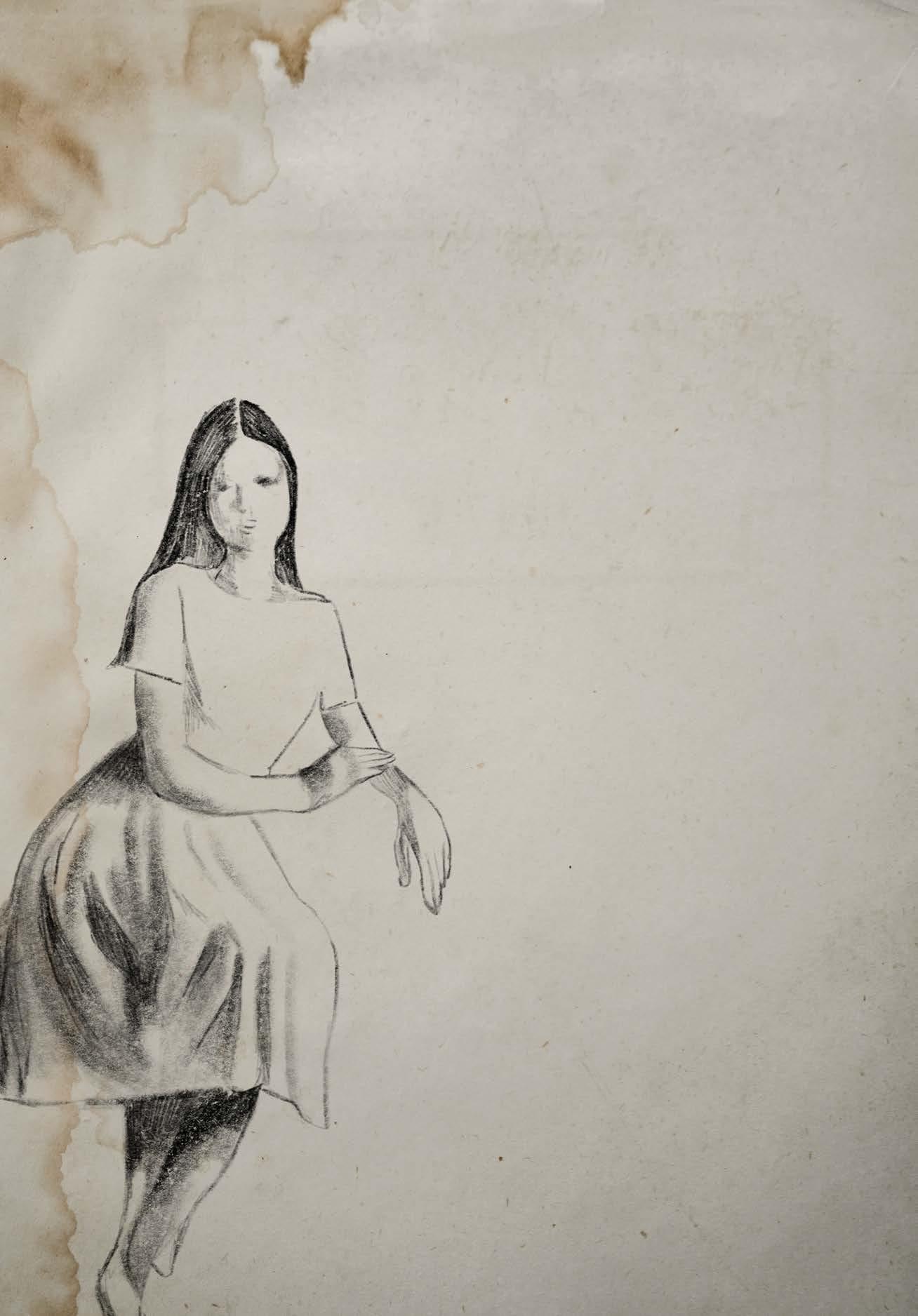
Spring 2023 Editorial 18
Designer: Megan Lam (Architectural Studies and Design)
has rocked the music community with her debut studio album, Preacher’s Daughter. The album relays the story of Ethel Cain, the character, who also functions as a semiautobiographical dramatization of Hayden’s own storied life. Preacher’s Daughter is a virtuoso performance of feminine rage and futility, a stunning critique on American society and the Christian religion, and a heart-wrenchingly captivating story. It is imperative to listen to and talk about the album in its order being that Cain meticulously composed its overarching storyline.
The album begins with Cain reflecting on her tumultuous relationship with her father, who died ten years earlier. It chronicles her journey from her small southern American town to the west coast, persuaded by a boyfriend to leave with him after she had run away from home. The saga takes a dark turn as we listen through the course of the relationship, in which her boyfriend begins to drug and prostitute her when they reach California, and she eventually falls victim to cult indoctrination. As Cain hallucinates and suffers this abuse in her boyfriend’s basement, we hear the song “Ptolemaea” at the album’s climax, possibly the greatest and most profound expression of feminine suffering the music world has ever seen, and a personal highlight from the album. It fades to an end with Cain reflecting on her life and death, speaking to her mother from the other side.
It’s a story like none other heard before in music, something so dramatically dark and hauntingly poetic. Ethel Cain tells a story that reaches into feelings we’ve all experienced while simultaneously creating a story so insane and unrelatable, cutting deeply into the human experience and creating a character to cry for.


While Ethel Cain shocked audiences through demented yet beautiful storytelling, Tyler, the Creator shocks by building offensive and often terrifying characters into his albums. Tyler, the Creator’s 2013 album Wolf, which followed the wildly controversial Goblin, brought Tyler into a more respected level of the music industry. Though still occasionally offensive and rude, the storytelling in the album placed it a step above Goblin and allowed his music to reach more mainstream appreciation. It was a transformative move in his music as he
pushed away from the aesthetic of his former rap group Odd Future, and a way to cement his individualism in the industry without relying on shock value.
Wolf follows the characters Wolf, Sam, and Salem, and centers around Wolf’s time at Camp Flog Gnaw, a summer camp for teenagers that he’s been sent to by a therapist. It also develops storylines from Tyler’s previous albums, Goblin and Bastard, completing a brilliant rap trilogy. Wolf, an alter ego of Tyler himself, meets Sam, who instantly makes clear his hatred for Wolf. He falls in love with Salem, Sam’s girlfriend, and when Sam finds out, he plans to kill Wolf as revenge. Sam’s backstory is revealed and we learn that he previously murdered his bullies, and Wolf gathers friends to go to war with Sam and end the fight. In the song “Trashwang,” the story culminates in a battle between the two sides. It is unknown what the outcome of the fight is, and the album finishes three songs later with Wolf speaking to his therapist, Dr. TC, about how he would have killed Sam.
It’s not confirmed where this story falls in the rap trilogy, but that’s part of the brilliance that allows listeners to construct the story in their own different ways. While still a deeply unhinged epic, it is lighter than the rest of the trilogy, which follow much darker paths. The switch between young love and naïveté on Wolf to violence and intrusive thoughts is jarring and cleverly formatted to take listeners through Tyler’s twisted mind.
Lorde’s Melodrama is a much more contained concept album, with the story occurring entirely within one night at a house party. Her sophomore album becomes much clearer and more profound when listened through this lens, and develops a deeper understanding of its overarching theme: loneliness. Though often thought of as a breakup album, the core of Melodrama is not about the breakup at all: it’s that singular feeling of isolation you feel, even when surrounded by others.
Entering the party with “Green Light,” the energy is high and the songs play through moments of connection as Lorde feels the rush of party drugs and alcohol. “Liability” is where the album takes a turn, and provides a moment-alone-feeling where you begin to feel all the feelings you were trying to run from by partying. What was once a glorious
high is juxtaposed with the melodrama of the party, the “terror and the horror.” She spirals out in these feelings, getting caught up in old relationships and her solitude. But by the end, she picks herself up and categorizes the party as “just another graceless night.” That’s the way things go; you go out to run away from your problems and they follow you through the night anyway.
These albums take a singular concept or storyline and follow it through with specific care. Individual moments are more than just isolated pieces; they are a means to a larger, more impactful end. Listening to them all the way through becomes an experience, and not just background noise. There’s not a single moment you can miss, or you risk skipping an integral part of the story. Concept albums remain one of the most beautiful and expressive ways to create a narrative and connect with the human experience.
• Lily Elwood (Journalism)
19
from MCR to MGK: The Evolution of Emo and its Subgenres

When asked to think of the word “emo,” one may imagine a black-haired teen wearing a band tee, dark skinny jeans, and too much eyeliner. While this style of dress dominated the 2000s emo era, not all emos fit this stereotype.
Born from punk rock, emo is a genre known for its raw, passionate lyricism, sensitivity, and emotional vulnerability. The popularity of emo music has ebbed and flowed over the years, but the recent reemergence of bands such as Fall Out Boy, My Chemical Romance, and Paramore proves that there is still a place for emo in popular culture. From emo rap to screamo, emo has inspired a wide variety of subgenres and continues to influence today’s most famous musicians.
Emo, then known as emocore, first appeared in Washington D.C.’s hardcore punk scene in the 1980s. Cited as the first true emo act, Rites of Spring took inspiration from punk band Minor Threat and expanded upon hardcore conventions by combining rock with deep, sentimental lyrics. For instance, in “For Want Of,” vocalist Guy Picciotto expresses his pain through the use of melancholic

imagery: “I - I bled / I tried to hide the heart from the head / I - I bled / in the arms of a girl I’d barely met.” While their legacy today is largely forgotten, Rites of Spring’s willingness to experiment pushed other D.C.-based bands to follow suit during the Revolution Summer of 1985.



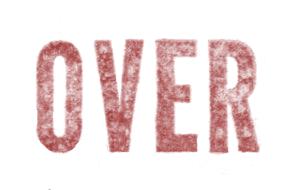

By 1986, most of the emo bands associated with the D.C. scene had broken up. The emo subculture, however, was brewing in other major U.S. cities. In New York City, punk band Jawbreaker expanded on Rites of Spring’s approach to lyricism and developed a cult following in the process. Lead singer Blake Schwarzenbach’s lyrics brimmed with personal and metaphorical musings and introduced poetry to the punk world.

In the 90s, emo was overshadowed by other punk genre derivatives and remained underground. During this period, punk rock and grunge went mainstream due to the success of Nirvana’s sophomore album, Nevermind Bands such as Green Day were propelled into the spotlight, and many punk and alternative rock records were certified platinum. Meanwhile, Weezer released Pinkerton, a moody,

Spring 2023 Editorial 20
genre-defining album about disenchantment, and the Midwest became a hotspot for the emo scene.

At the beginning of the 21st century, record labels like Deep Elm Records and Drive-Thru Records helped increase emo’s popularity by signing lesser-known artists and selling band merchandise in Hot Topic. Notably, Vagrant Records used the internet and extensive touring schedules to market emo to wider audiences, benefitting bands like Dashboard Confessional and Saves The Day. Warped Tour, a traveling alternative rock festival, also played a vital role in bringing emo to the masses until it became defunct in 2019.

By the time MySpace popped up in the mid-2000s, emo had become more than just a music genre. Teenagers began to adopt the aesthetic of bands like Panic! At the Disco and Bring Me The Horizon and nurtured the development of subcultures such as scene. Emo became the parent genre of screamo, emo rap, and pop punk and continued to influence related genres. Pop punk acts like Paramore, Fall Out Boy, Panic! At The Disco, and My Chemical Romance became the face of the emo scene by the late 2000s. Famous songs such as “Misery Business,” “Dance, Dance,” and “I Write Sins Not Tragedies” rose to the top of the charts and were universally loved by old and new fans. My Chemical Romance’s The Black Parade may be considered the quintessential emo album, and “Welcome to the Black Parade” the quintessential song. The album tells the story of a fictional cancer patient’s experience with life and death.
Opening with an iconic G note, “Welcome to the Black Parade” represents the culmination of the 2000s emo movement.


The end of the decade saw the return of emo to the underground. Most emo bands either rejected the emo label and segued into different genres, or disbanded. The public also began to reject emo because of its association with self-harm and suicide. Despite this, bands like Modern Baseball and Title Fight attempted to revive emo in the 2010s by emulating the original emo icons of the 90s and making the genre more inclusive with influences from unconventional sources such as math rock and shoegaze.
While emo fizzled out, some of its derivative genres gained recognition. Emo rap materialized from SoundCloud rap, a lo-fi version of hip-hop popularized on the music platform SoundCloud. Precursors of emo rappers, including Gym Class Heroes, collaborated with hip-hop artists and pop-punk bands to produce music inspired by both genres in the 2000s. A decade later, Bones and Yung Lean pioneered emo rap, but groups such as GothBoiClique made the genre thrive. Lil Peep, GothBoiClique’s most famous member, rebranded emo for contemporary audiences by rapping about depression, drug use, and other intimate topics. As a result, music critics believed he represented the future of emo, but his career didn’t last long; Lil Peep died from an overdose in 2017. With his death, as well as the deaths of other prominent emo rappers like XXXTentacion and Juice WRLD, emo rap disappeared from the limelight.



When the music industry thought emo was finally dead, Machine Gun Kelly appeared. While transitioning from rap to pop punk, MGK collaborated with both established and emerging emo musicians. In 2022, he released “Emo Girl” in collaboration with WILLOW. The song, while integral to the 2020s pop-punk revival, was described as generic and hollow by critics. Other artists including Olivia Rodrigo, with her hit single “Good 4 U,” and Origami Angel also paid homage to pop-punk.
It was with this revival of emo rap that brought back the fashion of the subculture. 2000s emo fashion resurfaced along with emo music; scenesters evolved into e-girls and e-boys, for better or worse. While e-kids originated from Tumblr, they became popular on TikTok and were commonly contrasted with Instagram’s VSCO girls. Combining emo, punk, and Japanese fashion, e-kids were known for their distinctive kawaii-style makeup and bleached stripe hair.
Throughout its over four-decade history, emo has continued to reinvent itself to stay relevant. While emo music and fashion has never looked the same, one facet of its character has always remained: its expression of personal thought and feelings, no matter how dark. This ability to be vulnerable and expressive has had a profound impact on its listeners and proves that there will always be a need for it, even if the styles change.
• Bryana Dawkins (Undeclared)

 Designer: Laura Mattingly (Communications & Design)
Designer: Laura Mattingly (Communications & Design)
21
Designer: Ava Ackerman (Business & Design)


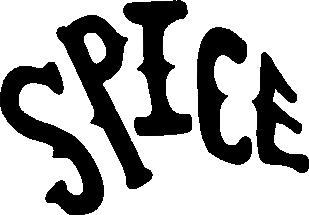



Spring 2023
Editorial 22
“How can I lose if I’m already chose?”

This line from Ice Spice’s “Bikini Bottom” sums up the Bronx rapper’s experience over the past few months. With the viral success of her breakout hit “Munch (Feelin’ U)” last summer, and the release of her debut EP Like..? on January 20th (with new tracks topping one million plays just four days after its release), the 23-year-old has truly experienced few losses so far over the course of her short career.
Ice Spice developed her artist pseudonym from a finsta page she made at 14 years old. In 2021, she began her rap career after meeting producer RIOTUSA at SUNY Purchase, gaining a steady stream of attention on SoundCloud that led to the eventual discovery of “Munch (Feelin’ U)” by Drake. Since then, buzz around the new artist has not faltered. Rolling Stone, NME, and Pitchfork rated Like..? highly, and devoted fans have amassed around Ice Spice from TikTok, hip-hop forums, and all sorts of corners of the Internet. With a distinct Bronx drill sound that incorporates the catchy, melodic elements of pop and R&B, Ice Spice’s music has a wide reach.
On TikTok, fans cheekily call Ice Spice this generation’s Princess Diana, which the rapper gracefully acknowledged — naming the second track of her EP after the beloved, deceased royal. In a similar way to Princess Diana, there is something captivating about Ice Spice: maybe it’s the way she can ride a Spongebob sample (see “Bikini Bottom”), her cold, matter-of-fact delivery, or the way in which she confidently handles scrutiny. On “In Ha Mood,” Ice Spice recognizes the power she holds over the industry, and the hate that has followed:
Let’s keep it a buck (huh)/ Bitches too borin’, got ‘em stuck in a rut”

She knows she has influence, and her belief in herself is clear. As Ice Spice’s career takes off, she is no stranger to doubt and hatred spewed by cynics in online spaces— vitriol that especially many female, queer, and Black artists have faced prior. Before even being given a chance to prove herself, Ice Spice is often called a “one trick pony,” “cringe,” or “lame,” and is constantly criticized for the sexual nature of her music. Online critics are quick to bash Ice Spice — as they do with many young Black women — for discussing her relationships, infantilizing her and attempting to pressure her into a more demure space.
Unsurprisingly, though men in hip-hop are typically allowed and often encouraged to express their sexuality through lyrics, women are condemned for doing the same. Artists like Nicki Minaj and Cardi B, who Ice Spice has cited as influences, have also been attacked for the “graphic” content of their songs. While this is not a new phenomenon, it means that backlash against Ice Spice in the male-dominated space of New York drill (and beyond) is inevitable. As it often happens, while Ice Spice is condemned for expressing her sexual prowess, she is still sexualized by her peers. Examples include being the subject of NLE Choppa’s explicit track “Ice Spice,” and also being forced to respond to allegations that she was in a leaked sex tape. Within the first few months of her career, Ice Spice already faces the same backlash that women in hip-hop have faced historically.

Whether r/hiphop101 thinks so or not, Ice Spice has potential. Her lyrical flow is novel, catchy, and comedic, and she knows how to utilize samples to her advantage. This may contribute to her virality, but it is in no way a fault to her artistry. Though it is uncertain to say for sure if she will have longevity in the music industry, she has the right attitude — and raw talent —to make it happen.
• Hannah Lowicki (Marketing)
“And I’m proud that I’m still gettin’ bigger (damn)
Goin’ viral is gettin’ ‘em sicker/ Like, what?
23
Audiences and critics alike often laud The White Lotus for its dramatic, mysterious plotlines and its nuanced characters performed by heartthrob cast members.
Season one of Mike White’s satire-drama anthology series premiered on HBO in July of 2021 and quickly became a hit. Not only does The White Lotus masterfully comment on social topics such as white privilege, wealth, and toxic masculinity, but it also provides hilarious dialogue, stunning visuals, and an even better sonic experience. The second season of The White Lotus is especially notable for its new theme song and its soundtrack full of deep-cut Italian tracks, adding yet another level of genius to the series.
Season two’s theme song takes a new spin on that of season one, revamping it to give this new season a distinct identity. Like many other HBO series, The White Lotus is a member of the theme song hall of fame (see: The Sopranos, Succession, Curb Your Enthusiasm, etc.). Chilean-Canadian Emmy-winning composer Cristobal Tapia De Veer composed both of the now iconic theme songs for each season of The White Lotus. Both “Aloha!” (the theme song from season one) and “Renaissance” (the theme song from season two) have the same melody, but they differ in instrumentals and composition.
Regardless of the changes in theme from season one to season two, both induce anxiety by including quick percussion and primal animal sounds. Bouncy instrumentals mask the unsettling and insidious undertones of the song, but only slightly. This mirrors an overarching theme of The White Lotus series: the characters are seemingly content, but their happiness merely facades their true flaws and barbarity.
In an interview with Variety, de Veer explained that he wanted “Renaissance” to evoke the same unease that “Aloha!” does. However, this time, de Veer wanted to make both “Renaissance” and the season’s score “more beautiful.” Season one complements its setting of Hawaii with a dark, jungleesque sound on “Aloha!” To better fit the second season’s new setting of Sicily, de Veer introduces a more operatic sound to “Renaissance.” de Veer’s collaboration with musician/composer Kim Neundorf helped create this embellished sound. Neundorf includes instruments such as Italian mandolins and violins to infuse more acoustics, giving the season its own sound — one that better reflects its location. The acoustics shine in various score tracks, such as in “Sicily Waltz” and “Lacero Puttanesca 2,” offering a more organic feel than does the techno-sounding “Renaissance.”
Spring 2023 Editorial 24
“Renaissance” begins slowly and gradually becomes more layered and upbeat. The mystical, playful harp entices you, drawing you into the canon. The choral vocals keep you there, anxiously waiting for what’s to come. Violin and piano eventually shuffle in. Then comes the turkey-esque vocals (similar to the monkey sounds of “Aloha!”) along with some swift maraca shakes. The track flexes its muscles at the one minute mark with a fantastic beat drop that soars “Renaissance” from just a theme song and to a stand-alone discotheque hit. Its EDM feel has caught the attention of many, ultimately leading to its virality on TikTok and Twitter. Several social media users argued for the abolishment of the “skip intro” button so viewers would have to enjoy the grooviness of “Renaissance.” The song’s popularity soon infiltrated clubs (including Boston’s very own Club Cafe), concerts (such as those of The Killers and Dominic Fike), and music festivals across the globe.
Another new aspect of season two’s sound comes from music consultant Este Haim, one third of the Haim trio band. Este visited her best friend, a producer for The White Lotus, on set in Italy. Haim’s intended one-week distraction from her heartbreak turned into a month of collaboration, friendship, and, most importantly, dancing and singing karaoke with Jennifer Coolidge and Mike White.
Haim’s soundtrack and de Veer’s score blend together to create a well-rounded musical experience. Just as de Veer combines newer techno beats with old-school Italian acoustics, Haim provides a varied soundtrack with Italian tracks old and new. “Città Vuota” pays homage to 60s Italy, just as White does by referencing the film L’Avventura (1965) in a scene set in Noto. On the other hand, “Ciao Ciao” brings a youthful sound, complementing the largely Gen-Z cast of season two.
The White Lotus proved itself noteworthy with its clever writing and brilliant acting from season one, but it proved itself especially artful with the music of season two. The choice to differentiate “Renaissance” from “Aloha!” is brilliant. As the series is an anthology, each season will have a different location, cast, and overall theme. Introducing a new sound that keenly reflects a distinct season’s messages helps to better identify it. Rumor has it that season three will take place in Thailand. Will de Veer adapt the theme song yet again? Will Haim return? We’ll just have to wait and see.
 • Lacie Foreht (Communication & Media Screen Studies)
• Lacie Foreht (Communication & Media Screen Studies)
25
Designer: Catherine Terkildsen ( Behavioral Neuroscience )


Cover Story 26 Spring 2023
For decades, folk and country were exiled from the playlists of everybody who claimed to have an ounce of music taste. Some exceptional artists made it through, with some pre-1989 Taylor Swift and whimsical Jack Johnson slipping through the cracks. Two massive genres of music became a guilty pleasure, listened to only through headphones by most everybody outside of rural America. Then, all of a sudden, a switch flipped.
The Lumineers’ simple, folksy love songs and Noah Kahan’s vulnerable pieces about growing up in smalltown New England were heard everywhere you went. The perpetrator? TikTok. The app itself, originally mocked over its cringe-worthiness, now is touted as the place to be, mirroring the effect it has had on the music industry. Seemingly overnight, countless Gen Z-ers decided that rap was out, and folk was in. But it was never that simple – this change has been brewing for longer than appearances suggest.
The folk genre itself has existed throughout the evolution of mankind, varying among civilizations. Country music originated alongside pop music, racing towards which genre would become truly popular. The aesthetic of folk and country has existed in popular culture for ages, including the era shunning these genres. “Gilmore Girls” touted a simple, close-knit culture based in small town New England that thousands of viewers wished to emulate. Netflix’s “Anne with an E,” based on L.M. Montgomery’s “Anne of Green Gables,” romanticized country-living for young girls everywhere, connecting it with friendship and teenage rebellion rather than the stereotypical landscape of middle-aged beer drinkers and unrefined tractor drivers. The same can be said for countless other TV shows and movies, introducing the idea that there is a multifacetedness of the human condition, stepping away from the sameness that teenagers tend to strive for.
But on TikTok, quirkiness isn’t necessarily discouraged. The Instagram girl who lives in Los Angeles was out, and small town chic was in once again. The algorithm plastered Gilmore wannabes on explore pages across the country, even the world. And the selfdescribed lower middle class touted their “crunchy” upbringing to the sounds of Gregory Alan Isakov and Joni Mitchell, to name a few. This movement was to the benefit of several new age folk and country artists, notably The Lumineers and Noah Kahan.
The Lumineers are the epitome of the folk revival, as if the quirky girl from tumblr wearing a flower crown and wielding a ukulele became a full-fledged musician. Their smash hit, “Ophelia” (2016), is a well known love song with bouncy vocals set to classic instrumentals. At a time that many cite as being “the good ol’ days,” bright acoustic folk fit the idealism of the era. Seemingly everywhere you went, a department store was blasting the band’s greatest hits, or somebody was humming to the tune of “oh, Ophelia, you’ve been on my mind girl since the flood.” Beyond the surface-level idealism, the group’s catalog
demonstrates diversity in both instrumentation and themes. In “Stubborn Love,” a breakout hit of the group’s self-titled debut album, an upbeat backtrack contrasts with melancholic lyrics about toxic relationships and second chances.
The beauty in this conflict was re-noticed on TikTok circa 2021, with the chorus being singled out for its compelling lyricism: “It’s better to feel pain, than nothing at all.” The relatability of folk lyrics played against the stigma that the genre was cringy, instead portraying folk music as having open arms to listeners from all walks of life. The Lumineers may have been an early example of the viral potential held by folk and country music, but they were certainly not the last as Noah Kahan reached viral fame in 2022 with his first full-length folk album. Despite having released a handful of viral songs in his prior two albums, such as “Hurt Somebody” (2018) and “Someone Like You (feat. Joy Oladokun)” (2021), Tiktok played a major role in the virality of the latter, but not to the extent it had with his third full-length album, Stick Season. The namesake of the album, its lead single, garnered massive hype even before the release. Lyrically, the album sees Kahan at his rawest, attracting those experiencing the same pain his music holds. Post-album release, nearly every song had its viral moment, allowing a diverse audience to share their own take on lyrics like: “I’m mean because I grew up in New England.” Other artists experiencing the same algorithmic luck include Drumming Bird with recent single “American Spirits,” Stephen Sanchez with “Until I Found You, ” and Rainbow Kitten Surprise’s “It’s Called: Freefall.”


The relative diversity within what goes viral on TikTok, as well as what is featured in popular media, points to a changing attitude within a generation. So why exactly is Generation Z, as well as Millennials, reclaiming the previously hated genres of folk and country?
While elders may point to technology and passing trends as the primary reason for every action young people take, this is an oversimplification of what modern folk music stands for to begin with. The simplicity of folk is intentional, meant to be passed down amongst generations. What was previously seen as sing-songy and bland has evolved into a well-respected work of art, with listeners recognizing the poetry in folk music across time. The songs that were once the epitome of cringe now, in the words of TikTok users, alter the listener’s brain chemistry. Common lyrical themes across the genre include abstract – and therefore widely relatable – concepts of the self like identity, mental health, and one’s relationships with others.
Beyond the concept of folk music, a shift in the persona of artists in a digital age has made the genre all the more accessible. Culturally, more and more celebrities are left-leaning, something unforeseeable before the recent reclamation of folk music. Openly queer artists like Brandi Carlile and Joy Oladokun have created a space that is welcoming of all identities rather than the stereotypical toothless hillbilly.
This widened audience is in turn appreciative of the aforementioned solidity of the genre in terms of lyricism and instrumentation. And somehow, in the midst of it all, the rest of the world melts away. Artist and listener form what feels like a natural bond, connecting over their shared humanity.
• Julia Towne (SLPA & Communication Studies)
27
Designer: Nick Alonzo (Architecture)



Cover Story 28 Spring 2023
Despite how it sounds, “a South-African cowboy and a motel-owning drag queen walk into a recording studio” isn’t the start of a joke with some bad punchline. Rather, it’s the true story of how country star Orville Peck and drag artist Trixie Mattel recorded a duet cover of Johnny Cash and June Carter Cash’s “Jackson” in 2021. And just two months prior, T.J. Osborne (one half of Brothers Osbourne) made public his gay identity in TIME magazine and became the first and only openly gay country artist signed to a major country label. Most recently, in January on MTV’s RuPaul’s Drag Race, country superstar Maren Morris apologized on behalf of the country community to a room full of drag performers on national television.
Peck, Mattel, Osborne, and Morris are just a few of the current artists actively changing the relationship between the LGBTQ+ community and the country/ folk genres — a relationship that has been historically strained by the conservative leanings of many country listeners and the exclusion of queer narratives in the genre. In some ways, these artists are just widening the spaces in the community already made for them by decades of queer artists before them, like Wilma Burgess or Tracy Chapman, that weren’t allowed to similarly shine. But with new country artists on the rise and louder allies than ever, is there hope for a more accepting, harmonious status quo between the two?
some “othered” stories through its representation of the working-class throughout the history of the genre — think Loretta Lynn’s “Coal Miner’s Daughter,” Mel Tillis’ “Sawmill,” or even Dolly Parton’s “9 to 5.” However, Allison Russell’s work represents a heightened level of intersectionality, which is a social and political framework that analyzes and understands how all the different aspects of individual and group identity create systems of discrimination and privilege. The kind of intersectionality championed in Russell’s work, where every underrepresented racial and sexual identity is celebrated and heard equally, has been incorporated into country at a much slower pace.


The Disrupter
It was somewhere between March 16 and March 26 of 2019 when “Old Town Road” was unexpectedly moved from Billboard’s Hot Country Songs chart to Hot Rap Songs. The explanatory statement from a Billboard representative seemed flimsy at best: “[it] does not embrace enough elements of today’s country music to chart in its current version.”
“Tap, tap, tappin’ on your window screen… Gotta let me in Persephone…”
Wistful lyrics like these have all the elements of a classic country love song. But the twist comes in the tenor; drafted from one teenage girl to another, “Persephone” is a raw and soulful representation of Allison Russell’s queer identity. The Canadian folk artist and advocate for sexual assault survivors has crafted a unique role for herself in the genre, imbuing deep empathy and truth-telling into her efforts to “reclaim the banjo’s ancestral African-American roots.” Russell’s Grammynominated Americana music has served as a stunning subversion for those not typically centered in the gender-normative genres of country and folk music: Black people, queer people, and all of those generally lost or othered in society.
Country has admittedly centered
None know this better than country band Lavender Country and their lead singer/guitarist Patrick Haggerty, who released what’s considered to be the first country album ever by an out gay performer. The eponymous 1973 album, Lavender Country, was unabashed about its queer defiance and content in a genre that refused to be ready for its inclusion. One Seattle radio host was even fired from their local KRAB station in Seattle for playing on-air one of the album’s tracks, “Cryin’ These Cocksucking Tears.” As their voices were stifled, so was their commercial success. The band’s musical career flatlined until the early 2000s, when a newfound fanbase led to the rerelease of the album to a broader audience, the revival of the band, and their first performance in over three decades. And with the 2019 release of their second studio album, Blackberry Rose, Lavender Country’s queer country joy went from unplayable on Seattle radio to celebrated in national publications in just under 50 years.
The list of queer artists only seems to grow every day. Queer country staples like Brandi Carlile and the Indigo Girls continue to triumph in the genre, yet there is so much more work to be done. At the same time that trans rights are facing political assaults at the local and national levels, trans artists particularly have to fight to carve a space for themselves in the country, Americana, and folk genres. The CountryQueer online publication highlighted this in their report “The Case Of The Missing Trans Country Artists,” which explained that so many

The backlash was immediate and sharp. As Vox columnist Allegra Frank noted, people immediately criticized Billboard for feeding into rigid limitations about who or what qualifies as “country enough.” And for many of these fans, it was not lost that Lil Nas X was an openly and proudly gay, Black kid from Atlanta. He was subverting musical stereotypes in a largely white, largely heteropatriarchal genre of music.

While the single has so far been Lil Nas X’s only dip into the country music genre, it’s clear the move had a massive cultural impact on what country is and could be.
“Old Town Road” peaked at number one on the general Billboard Hot 100 for a recordbreaking nineteen consecutive weeks. His label won the Music & Sound Recordings Award from SAG-AFTRA “for work that exemplifies equal access” of LGBTQ+ and “other misrepresented or underrepresented groups.” The cultural moment culminated at the Country Music Association Awards: “Old Town Road” was named “Musical Event of the Year” and Lil Nas X became the first openly gay black musician in history to take home a win from the ceremony.
Lil Nas X’s career has largely remained in rap and pop, where he continues to subvert industry norms through unapologetic dress, dancing, and representation. But just for one summer, he was a cowboy – and the queer community in country music remains better off for it.
Designer: Sarah Liu (Journalism)
29
trans singers still do not feel a home for themselves in the community. That’s why the existence and success of the few trans artists in those genres — folk-rocker Namoli Brennet, activist-musician Ryan Cassata, and two-time Grammy-nominee Cidny Bullens come to mind — remain so important to an intersectional, welcoming music industry for the whole spectrum of queer talent.
“Coming from country music and its relationship with LGBTQ+ members, I just want to say I’m sorry,” Morris said to a room full of dragged-up faces on Untucked, following the January 13th episode of “RuPaul’s Drag Race.” The country singer had come onto the show as one of the week’s special guests, alongside rotating judge and LGBTQ+ activist T.S. Madison. “I love you guys for making me feel like a brave voice in country music. So I just thank you guys so much for inspiring me.”
In a prior interview with GLAAD, Morris attributed her advocacy to the death of her uncle from the AIDs crisis in the 90s and to her many queer-identifying friends in her
The Champion
“Why can’t they be as miserable as us heterosexuals in their marriages?” This line from Dolly Parton just last year on an Australian radio program, speaking in support of efforts for marriage equality in Australia, deftly summarizes the exact kind of allyship the country legend has brought to her craft and public persona for years. Her lighthearted and non-judgemental support is no less bold as it is country and Christian. Parton describes her allyship as not despite her faith, but guided by it.
Parton’s support for the queer community has spanned decades, back to the 1991 release of her song, “Family.” While the lyrics would be banal in today’s world – “Some are preachers / some are gay … But not-a-one is turned away when it’s family” — this was both incredibly early and explicit support in country and the broader music industry, with a Christian artist framing being gay as equally acceptable to being a
high school theater department. The country artist furthers the allyship mold past passive inaction, regularly making headlines for her throaty defenses of the queer community. Just this past August, Morris clapped back at Brittany Aldean, wife of country crooner Jason Aldean, for distasteful comments comparing growing out of a “tomboy” phase to gender transitions. “It’s so easy to, like, not be a scumbag human? Sell your clip-ins and zip it, Insurrection Barbie,” Morris tweeted. She was joined by several other artists like country-pop performer Cassadee Pope, who implored beauty influencers and country artists alike to “include LGBTQ+ people in their messaging.” It’s hard to imagine that a similarly insensitive comment would have received such pushback from other country stars even ten years ago.
Morris is far from the only loud-andproud public ally in country music. Just this past year, country star Kacey Musgraves was the recipient of GLAAD’s Vanguard Award, which honors “someone who has made a significant difference in promoting [the] equality and acceptance of LGBTQ+ people.” In 2014, Musgraves became the first country artist to perform at the GLAAD Media Awards, where she performed her smash hit from her debut album, “Follow Your Arrow.” At the time of the single’s
release, Musgrave’s label warned her that the song’s lyrics — “make lots of noise / kiss lots of boys / or kiss lots of girls / if that’s something you’re into / … just follow your arrow wherever it points” – would lead her career to “crash and burn.” Instead, the song charted upon release and quickly became an anthem for queer country fans.



Musgraves has continued to embody her allyship even as her fame and recognition have only grown. After guest judging on season 4 of /Drag Race: All Stars/, she invited winners Monét X Change and Trinity the Tuck to join her onstage in Los Angeles to perform during her tour. She has also continued to prominently collaborate with queer artists, such as Carlile and Troye Sivan, while MUNA and King Princess joined her on tour last year. Musgrave and Morris’s very public allyship, particularly to drag artists in a time when the art is under the conservative media microscope, are just two examples that prove heterosexual artists can be bold in supporting the LGBTQ+ community without wide consequence to their country career.
However, a lack of wide consequence is not equivalent to a lack of pushback. Shortly after Musgraves released “Follow Your Arrow,” Colorado pastor Kevin Swanson went viral in his hostility, accusing the singer of “promoting homosexuality” and noted
preacher. Her allyship has again and again been reaffirmed. In a 2009 interview during the fight for marriage equality in the States, she refuted the notion that being a country artist from Tennessee would make her unaccepting of the issue: “‘Sure, why can’t they get married? They should suffer like the rest of us do.”
The trans community has not been left behind in Parton’s advocacy. In 2005, she received an Academy Award nomination for her song “Travelin’ Thru,” a heartwarming contribution to a film about trans joy and self-love called Transamerica. Along with publicly criticizing anti-transgender bathroom bans and including trans drag artists in her performances, the “Iron Butterfly” has continued to use her faith as a divine mandate for complete acceptance and safety for trans people to be who they are. Parton has worked to actively and publicly redefine the relationship between
country, Christianity, and queerness in many instances over decades, earning her much love and respect among the queer community.

Cover Story 30 Spring 2023
that “she would have been killed” for releasing that song in an earlier era. Homophobic country fans flooded her social media comments and inboxes, and Morris faced a similar tidal wave of resistance. Fox News’ Tucker Carlson, a controversial conservative political commentator, caught wind of the Aldean drama and, live on his show, called Morris “a lunatic” and “some kind of fake country music singer” — as if allyship and the country genre fundamentally cannot coexist. Yet, rather than balking,

both artists remained steadfast in their allyship. Musgraves refused to back down from her subsequent GLAAD performance and Morris raised $100K for a trans youth hotline by slapping Carlson’s “lunatic” quote on a t-shirt. The changing tides of country famedom and fandom are clear, but they depend on this kind of continued support from stars in the genre despite conservative resistance.

 • Jacob Kemp (Political Science)
• Jacob Kemp (Political Science)



31
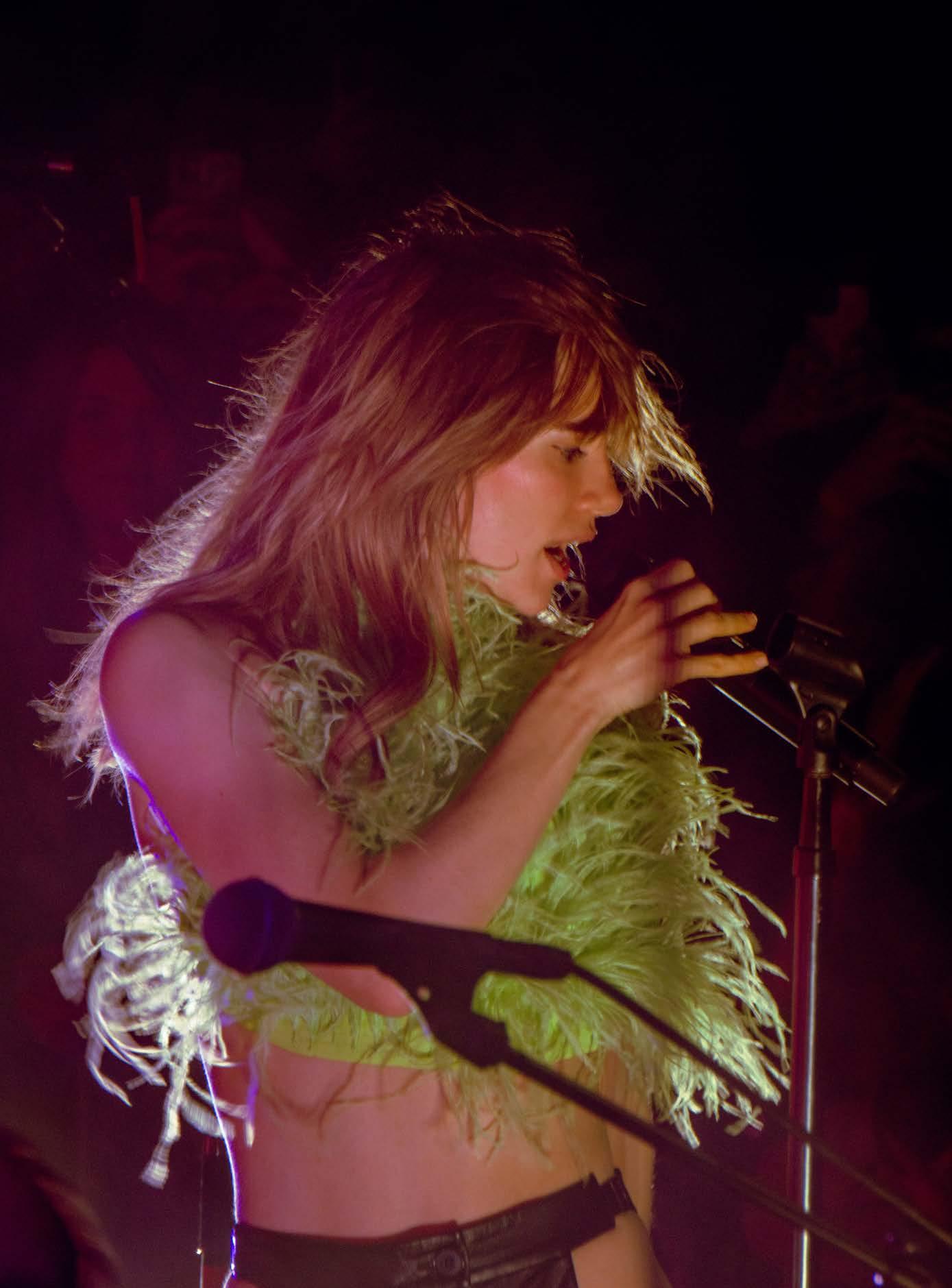 Suki Waterhouse, Paradise Rock Club
Photo by Mukki Gill (Mechanical Engineering and History)
Suki Waterhouse, Paradise Rock Club
Photo by Mukki Gill (Mechanical Engineering and History)

 MAX, Royale
Photo by Emily Zakrzewski (Civil Engineering)
Emlyn, Sonia
Photo by Matt Rose (Communications and Media and Screen Studies)
MAX, Royale
Photo by Emily Zakrzewski (Civil Engineering)
Emlyn, Sonia
Photo by Matt Rose (Communications and Media and Screen Studies)
 Zoe Sparks, The Red Room
Photo by Anna Kelly (Health Science)
Zoe Sparks, The Red Room
Photo by Anna Kelly (Health Science)
 almost monday, The Sinclair
Photo by Helen Cai (Health Science and Business Administration)
almost monday, The Sinclair
Photo by Helen Cai (Health Science and Business Administration)
Lil Mariko is no stranger to duality. In the music video for her iconic “Where’s My Juul??” she sings to producer and boyfriend Jared Soule, professionally known as Full Tac, “I swear to God, bitch, if you stole my fucking JUUL / I will break each and every one of your goddamn fucking fingers,” in her signature cutesy voice while wearing pigtails and pink lipstick. A minute later, she runs through her neighborhood in a nicotine withdrawal-induced rage, stomping on the pavement in her Mary Janes, pink pleated skirt, white laced shirt, and heart-shaped earrings. In the two years since posting this video – which has garnered nearly 20 million views – Lil Mariko has released an album, earned a Four Loko sponsorship, collaborated with Rico Nasty, and switched to Flum Vapes.

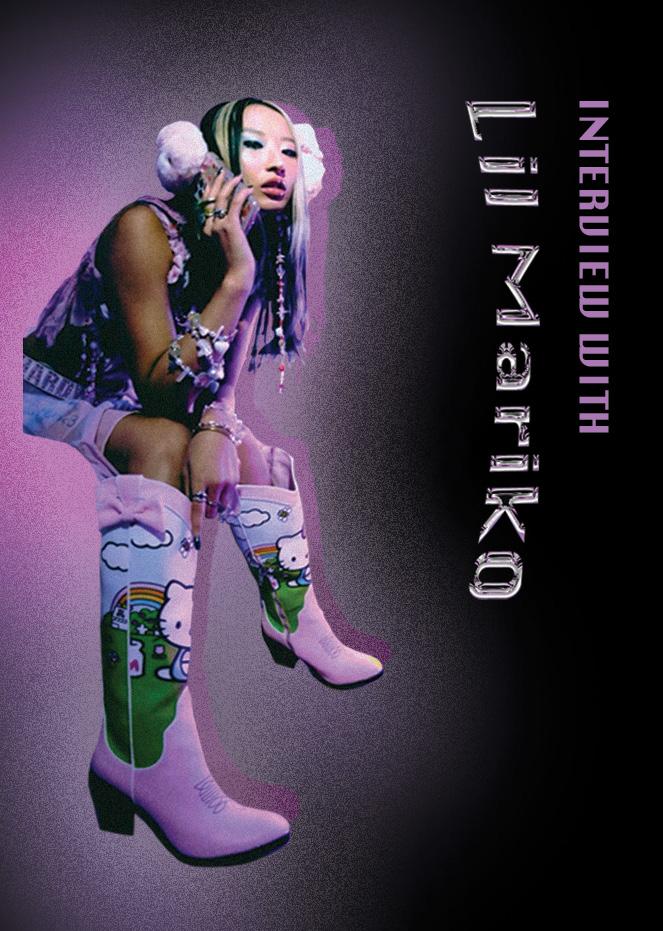
Tastemakers Magazine recently spoke with Lil Mariko, born Kat Zhang, over Zoom about her upcoming European tour, her artistic persona as a character, and combatting stereotypes.
This interview has been edited for brevity and clarity.
Spring 2023 Interview 36
Photo by Ryan Scullin, Look by @Sparklebabygem
Tastemakers Magazine (TMM): What have you been listening to lately?
Lil Mariko (LM): It’s been kind of all over the place. I’ve been listening to a lot of shoegaze. I’m wearing a Loveless shirt right now, by this band, My Bloody Valentine. I listen to them a lot. They’re kind of like my go to. What else? Some math rock type shit, Animals As Leaders… and embarrassingly enough, a lot of Yeat, which I’d prefer people didn’t know. But it’s okay. It’s my guilty pleasure.
TMM: You’re starting your “Slag Tour” in a week, right? Is this going to be your first time tour or performing outside of the country?
LM: No, actually at the beginning of– It’s 2023, right?

TMM: Right.
LM: So beginning of 2022, I went on tour with Dorian Electra for their Europe tour. And so we saw lots of Europe, which is fun. And I did a London show as well.
TMM: So are you looking forward to going back?
LM: Yes and no. I mean, having the opportunity to travel at all is really cool to me, and that’s very exciting. But I’m also not looking forward to how fucking cold it’s going to be. I know it’s going to be freezing. Part of the reason why I chose to live in L.A. was because I’m not a winter person at all. Because I’m always not dressed warm enough. But this time, this time I think I might be okay. I bought a bunch of heating pads and I’m gonna line my jacket in heating pads and see if does anything for me.
TMM: Your Twitter bio is “I make terrible music” and your TikTok bio is “I make terrible music sometimes.” Is this self-deprecation or tongue in cheek?
LM: I mean, I think it’s a bit of both because, like, the goal of my music is not for it to sound good. Does that make sense? I want to make music that you’re like, ‘Wow, this is so fucking stupid. But why it slap though?’ That’s the general goal of my music. Also, I feel like if I approached it too seriously, it [would] lose some of its charm. I’m aware of how it sounds.
TMM: How would you describe the visual aesthetics of your music, like your album art, your music videos? I’ve noticed motifs of Sanrio, guns, and leather. Is that all curated or is it just what you’re into?
LM: It’s a bit of both for sure. Some of it is curated in the sense where it’s a little bit over the top, but generally it is kind of stuff that Jared and I are just sort of into. I mean, you can see my room. I have a giant thing of plushies. But yeah, I guess going into the aesthetic of the character or persona that I do for music, it is a character at the end of the day, but it is a very much exaggerated version of myself. I think there are still elements of it that I think resemble me, but like me times a million.
TMM: In my eyes, I kind of feel like it’s Lil Mariko versus Kat. It’s kind of like – I don’t want to say drag, but the way that it’s
exaggeration turned up to a thousand.
LM: Yeah, exactly. It is like a little bit of a drag thing. Cause I think when it comes to drag queens, it is like it’s a persona, but it’s still them, you know? They thought of the concept, their idea manifested into this stage presence and you know, obviously, once they take the drag persona off, they’re not always that person on the stage all the time. But you can tell you need to be, like, comfortable with your stage character. I think it becomes too difficult to even put the costume on you if it’s a totally different person.
TMM: Is your brother and the rest of your family into what you’re doing?
LM: To be honest, they don’t really know a lot about what I do. I think they’re kind of on this ‘don’t really ask and don’t tell’ type thing. My brother knows a little bit more because he actually told me he has friends who are fans, which I think is funny. But I’m sure it’s a little jarring for them to see, when they type my name, “Hi, I’m a Slut” pop up.
TMM: A lot of your music can get pretty explicit, in a humorous manner. What makes you want to explore these themes in this tone? Does humor bring light to anything specific?
LM: I guess in my head, I’m kind of combating like that Asian woman stereotype of being submissive and soft and shit. Of course, there are other artists who have very much been explicit about the content of their lyrics, but very rarely do I see it packaged in the same way. I feel like especially as an Asian woman, it’s kind of seen as unacceptable for me to be doing these kinds of things. In my own personal life, though I think (laughs) I am not this extreme, but, once again, it’s like this character is myself, but like...
TMM: Dialed up?
LM: Yeah.
TMM: What do you want from the world in 2023?
LM: You know, it’d be cool if people turned down the racism and the homophobia in 2023, because I don’t know what the fuck happened in the last couple of years, but shit has really… yikes. I don’t know what it is, but people think it’s suddenly acceptable again to be, like, fucking horribly racist and homophobic, but let’s dial it back. Hopefully those people go back to being ashamed of being racist. Bring that back in 2023.
TMM: And then what can we expect from you?
LM: With the new music and in general, I’d just like to start pumping out more tracks and hopefully with that, I’m hoping my musical discography will grow as well as my sense of sound, because I feel like Jared and I, even though we do currently have a distinct sound, I would like to grow it. In what direction? I’m not sure, but we’ll see.
• Trevor Gardemal (Journalism)
37
Designer: Caroline Xiong (Business Administration & Design)
One of the most influential artists of all time, David Bowie was one of rock music’s most prolific visionaries. His discography spans twenty-six studio albums, numerous live albums, and over seventy music videos. It would be impossible to cover Bowie’s entire career justly in a single article. Rather, this is a snapshot of Bowie’s discography, a selection of the albums that would define the most pivotal moments in his career. From his first major single to the final album written on his deathbed, Bowie’s career is one of the most impressive acts the music industry has ever seen.
Every artist has a muse, and David Bowie was no different. It’s fitting that his first commercial success, the 1969 single “Space Oddity,” was written about his favorite subject: outer space. In the song, Bowie sings from two different perspectives, crafting a conversation between an astronaut named Major Tom and the corresponding Ground Control as his spaceship’s connection to Earth is lost. As Major Tom drifts further into the ether, Ground Control informs him that he’s achieved stardom: “the papers want to know the shirts you wear” they say, just before Major Tom comes to the conclusion that he has left Earth “forevermore.”

The song is the first track on Bowie’s sophomore album, which shares the same self-titled name as Bowie’s first 1967 album. Both David Bowie albums share a similar gentle, folk rock sound reminiscent of other popular British acts such as the Beatles or the Monkees. They lack the theatrics and avant garde visuals that would come to define Bowie as a truly unique artist. Instead, both David Bowie albums sound like imitations of other musicians of the British Invasion, and were aptly met with lackluster success.
“Space Oddity” is the exception from an otherwise mundane album, and would change the trajectory of Bowie’s life and career. The song, which was coincidentally released five days before the Apollo 11 launch, climbed the charts to a top 5 spot in the UK. RCA would re-issue Bowie’s second self-titled album with a new, fitting name: Space Oddity In many ways this album and its titular track lay the foundation for Bowie’s tumultuous career to come. Major Tom might just be a character, but like the spaceman, Bowie had left the life he knew forevermore, drifting off into the stars.
Recommended Tracks: “Space Oddity,” “Cygnet Committee,” “Janine”


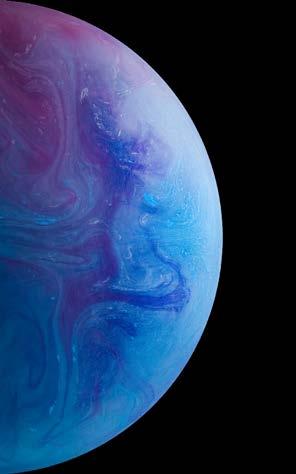


Spring 2023 Feature 38
HUNKY DORY 1971
The release of Bowie’s fourth studio album marked a definitive break from the mold formed by his earlier work. Inspiration drawn from Bowie’s folk rock days is still legible throughout the album, particularly in its more tender moments such as the closing track “The Bewlay Brothers.” Cleverly woven into these touches of folk rock, however, are influences of pop music, rock, and cabaret. The result is grandiose and anthemic, the first of Bowie’s albums that is truly emblematic of his legacy as a musician.
Bowie’s new direction is made immediately clear with “Changes,” the first song on the album. Backed by a full orchestra
and driven by a cabaret-inspired piano score, the new sonic direction of Hunky Dory is bold and refreshing. Bowie’s voice is distinct and captivating, fueled by an energy that builds into emphatic cries before falling back into a gentle croon.
Along with other greats like “Oh! You Pretty Things” and “Queen Bitch,” Hunky Dory is home to one of the greatest songs of the 1970s. “Life on Mars?” is a powerful ballad that exemplifies Bowie’s tact as a storyteller. Told from the perspective of a young girl who yearns to go to the movies, “Life on Mars?” laments over the mundanity of life and art. Within his poetic lyricism,
Bowie speaks to his own desire to create an escape through art, and wrestles with the idea of whether it is possible for him to create something truly new and unique. Through its cathartic swells and beautifully crafted instrumental arrangement, “Life on Mars?” answers the very question it asks with a timeless masterpiece of a song.
Recommended Tracks: “Life on Mars?,” “Changes,” “Queen Bitch,” “Oh! You Pretty Things”
Often referred to by the shortened name Ziggy Stardust, Bowie’s 1972 album The Rise and Fall of Ziggy Stardust and the Spiders from Mars is arguably his most ambitious and impactful project. The eponymous character, Ziggy Stardust, is an alien who has come down to Earth with the message that life as we know it will end within the next five years. This scene is set by the first track of the album, “Five Years,” which is Stardust’s desperate cry of warning to humanity. The following songs on the album serve as an anthology of the ensuing years after Stardust first delivered his message, told from varying perspectives. In “Starman,” humans retell the story of Ziggy Stardust, who has become somewhat of a man of myth. It’s a call to listeners to make their time on Earth worthwhile, and offers the
hopeful side of the alien’s message: “He’s told us not to blow it / ‘Cause he knows it’s all worthwhile.” The actual starman faces a darker end, however, as the fame he is met with eventually drives him towards his own demise. The final track of the album, “Rock ‘n’ Roll Suicide,” is the thematic conclusion to the album: the death of Ziggy Stardust.
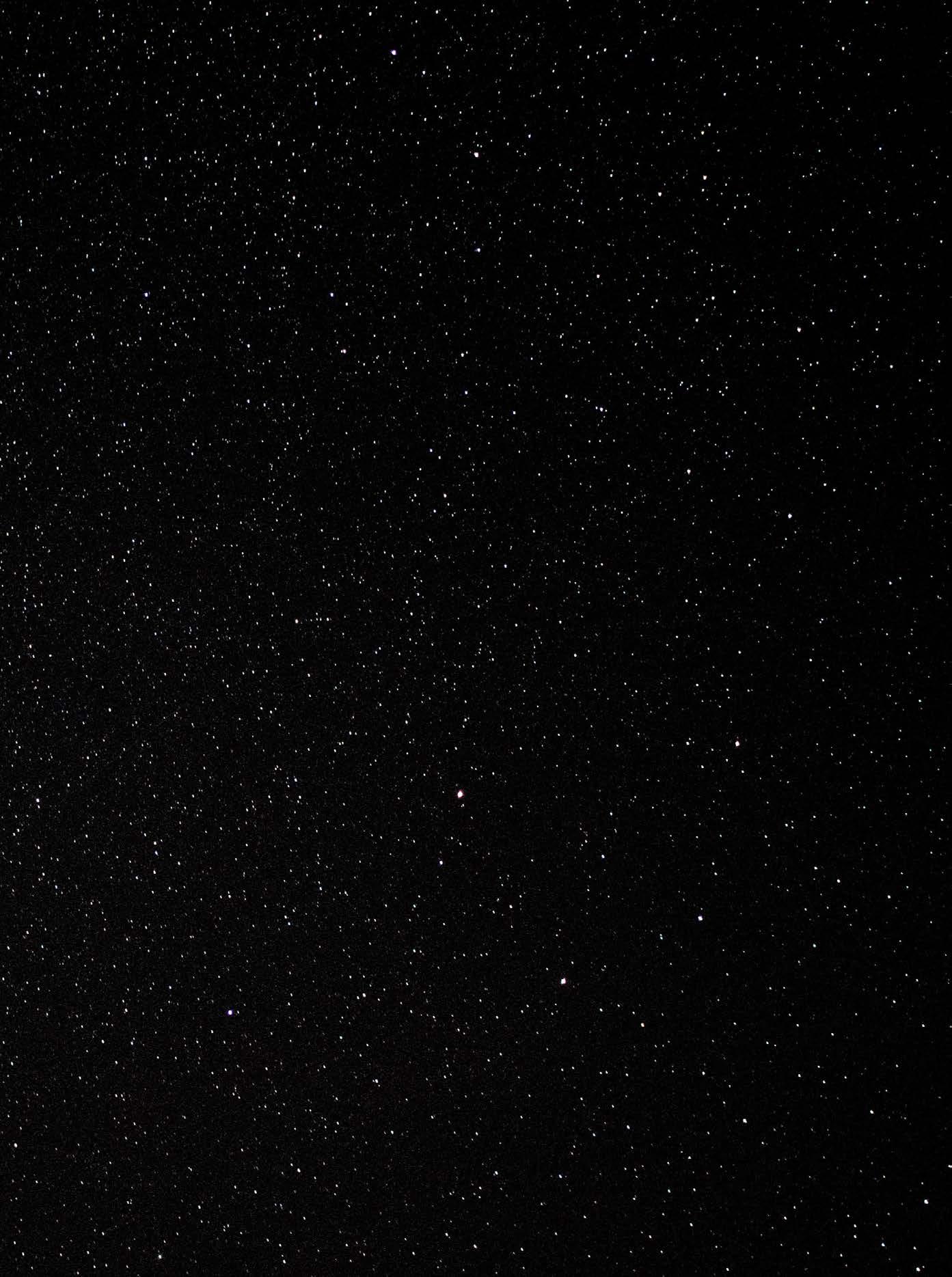
While a masterpiece in its own right, the actual music from this album is only half of what makes Ziggy Stardust so memorable. The release cycle that came with this record is the first time that Bowie fully embodied a character, a habit that would come to define his career. Ziggy’s alien identity was an outlet for Bowie’s flamboyant and revolutionary androgynous fashion. His looks were outrageous; Stardust was characterized by a
shocking red mullet and a gold circle painted on the center of Bowie’s forehead. His work with designers such as Kansas Yamamoto put Bowie on the map not just as a generation-defining musician, but as a fashion icon as well.
Recommended Tracks: “Five Years,” “Starman,” “Moonage Daydream,” “It Ain’t Easy”
Designer: Jamie Tishkoff (Business and Design)
39
A play on the phrase “a lad insane,” Bowie’s sixth studio album Aladdin Sane was written at the height of his stardom. Largely written during the US leg of his Ziggy Stardust tour, Bowie’s new character is more of a typical rock ‘n’ roll star — one engrossed in the world of sex, drugs, and the overall insanity of the 1970s rock scene. The character of Aladdin Sane lacks the moral mission of Ziggy Stardust; Bowie himself would describe Aladdin Sane as a sellout. Still, this superficiality gives way to an incredible feat of an album.
The album opens with “Watch That Man,” whose gritty electric guitar chords and backing vocals draw heavy influence

from other iconic rock groups such as the Rolling Stones. Bowie’s take on a Stones song is actually featured on the album, and he adds his own twist to a classic with his cover of “Let’s Spend the Night Together.”

The influence of American musical traditions are also apparent on the album; title track “Aladdin Sane” features an extended piano solo that is more reminiscent of blues than the cabaret of his earlier accompaniments. Sonically, Aladdin Sane is a hallmark of 70s rock that is deeply reflective of Bowie’s newfound success.
Recommended Tracks: “Watch That Man,” “Cracked Actor,” “The Jean Genie”
Following a stay in rehab for his cocaine addiction and an explosive divorce, Bowie relocated to West Berlin with fellow musician Iggy Pop in an effort to shake their worsening drug addictions. It was here — in a divided city, still struggling to recover from war — that Bowie would write the three albums that came to be known as his Berlin Trilogy. Both sonically and thematically, the Berlin Trilogy albums take a sharp turn from Bowie’s glam rock era and into the more introspective and experimental world of new wave synths. Recorded with the help of other esteemed musicians such as ambient master Brian Eno, the Berlin Trilogy stands as a testament to Bowie’s versatility and growth as a musician. Heroes, the second of these albums and the only to be fully recorded in Berlin, is one of the most remarkable records to come out of Bowie’s career. The first side of the album introduces an upbeat, New Wave-inspired sound. The titular track, “Heroes,” which is a six-minute love ballad that builds into a cry, is rightfully one of Bowie’s most famous works. Things take a sharp turn with side B, however, which features five ambient songs that do not have any lyrics.“Moss Garden” is one of these tracks, during which Bowie
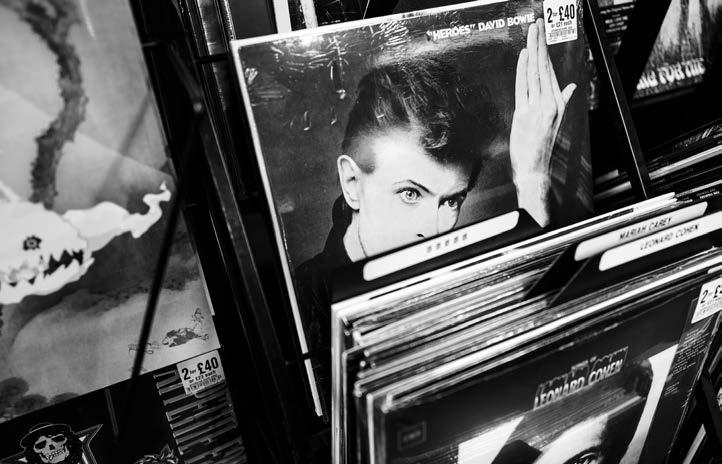
softly plucks at the strings of a koto against the backdrop of radiant synths. Inspired by a garden Bowie once visited in Kyoto, “Moss Garden” perfectly encapsulates the peace Bowie hoped to find within his Berlin Trilogy.
The calamity of glam rock has faded into oblivion, replaced by a gentle hum.
Recommended Tracks: “Heroes,” “Blackout,” “Moss Garden”
Photo by Chris Bolandr via Unsplash
Spring 2023 Feature 40
Photo by Christina Radevich via Unsplash
With Blackstar, the final act of one of the world’s brightest stars, David Bowie transforms his own death into a work of art. The album was released on January 8, 2016, Bowie’s 69th birthday. Two days later, he passed away after a private battle with cancer.
Uncannily self-aware, Blackstar makes for a difficult listen. The first words of Bowie’s final single, “Lazarus,” are a command to his listeners: “Look up here, I’m in heaven.” The accompanying music video features a feeble and gray-haired Bowie on a hospital bed, fighting against the inevitable. It was during the filming of this music video that Bowie would receive the news that his liver cancer was terminal, and he was given mere months to live.
As one might expect from an album written on the artist’s deathbed, Blackstar is more subdued and darker in theme. According to his producer, Tony Visconti, Bowie hoped to avoid rock n’ roll with Blackstar. His inspiration was drawn from contemporary rap artists such as Death Grips and Kendrick Lamar, as well as the experimental electronic group
Boards of Canada. The record is driven by uneven, syncopated drum beats that evoke feelings of unease, paired with Bowie’s voice that is raspier and less melodic than in his earlier music.
With the title track of the album, Bowie details his own ascent into the heavens. He repeats the phrase “something happened on the day he died,” drawing theoreticals about life after his own death. The hook of the song is a cry told through Bowie’s distorted vocals: “I’m a blackstar.” Variations on this lyric deny some of the roles Bowie was associated with on Earth; “I’m not a filmstar” and “I’m not a popstar,” for example. Through these lyrics, Bowie rejects his Earthly legacy and assumes his place amongst the stars.
Recommended Tracks: “Blackstar,” “Lazarus,” “I Can’t Give Everything Away “
 • Jessica Gwardschaladse (History, Culture, and Law)
• Jessica Gwardschaladse (History, Culture, and Law)
41
Hyperpop is an electronic music phenomenon that has taken the internet by storm. The term was first widely coined when a Spotify playlist titled “hyperpop” was released, including music from a multitude of electronic musicians that made ridiculously over-engineered pop music. However, many artists thrown into this group actively dislike the label since it threw them into a musical niche they were not always trying to achieve. Regardless, due to the quick popularization of the genre, many musicians making flashy Internet-inspired electronic music get grouped under the hyperpop genre, for better or for worse. 100 gecs, one of the most well-known hyperpop musicians, highlighted collaboration as a core value in the growth of hyperpop. Looking back on hyperpop’s evolution and the musicians involved with the movement, it is evident that collaboration is essential to what hyperpop is today.
The first record label releasing music that can be considered a precursor to hyperpop was PC Music. Founded by producer A.G. Cook in 2013, PC Music releases larger-than-life pop that draws from aesthetics of consumerism and incorporates an uncomfortably textural sound. Every few years, PC Music releases a compilation album featuring most, if not all, of the artists on its roster, including A.G. Cook, Danny L. Harle, Hannah Diamond, GFOTY, umru, and EASYFUN.



But perhaps the most singular influential figure to developing the genre of hyperpop was SOPHIE. While not falling into the exact conventions of modern hyperpop, SOPHIE’s music included metallic sonic elements and pitch-toned vocals that have since become staples of the genre. “BIPP,” one of SOPHIE’s first singles, includes repetitive high-pitched vocals and whirring mechanical flourishes over a bouncy bass-heavy beat, many of which became popular in more recent hyperpop songs. Her song “Immaterial,” which celebrates the fluidity of gender and identity, is considered one of the notable hyperpop-adjacent songs to explore LGBTQ+ related themes. While
releasing solo music, SOPHIE also worked with multiple musicians within and outside of PC Music.
While the ethos of collaboration was integral to the emerging hyperpop scene, its significance to the genre was solidified by the band 100 gecs. After sound bites from their songs went viral on TikTok overnight, the duo played a large part in popularizing the genre. Shortly after the peak of their virality, 100 gecs made a move that allowed fans truly interested in their music to delve deeper into hyperpop: they released a collaborative remix album of their debut album, 1000 gecs. This remix album, 1000 gecs and the Tree of Clues, featured musicians who were previously associated with hyperpop, as well as artists who were further outside the genre’s scope but with similar identities and maximalist styles. Upon its release, 100 gecs was asked to curate the already infamous hyperpop Spotify playlist, and they included many songs from this release on it. The large number of collaborators and marketing behind 1000 gecs and the Tree of Clues made the album more accessible to new listeners than previous hyperpop releases. Due to these factors, people who were interested in this quirky iteration of electronic music or who had seen themselves in the subject matter of these songs were able to easily learn more about a genre that barely broke into the mainstream.
The artists that were featured on 1000 gecs and the Tree of Clues all make different types of abrasive music, but most fall under what can be considered hyperpop. Danny L. Harle and Dorian Electra are both featured, but the former has a more conventional EDM style while Dorian Electra’s music is driven by the political connotations of queerness and the concept of evaluating and dismantling toxic masculinity. Even though these musicians take inspiration from a wide range of genres and movements, they still synchronized their styles and were able to create an album filled with energetic and mindnumbingly absurd electronic pop music.
After 100 gecs blew up, a younger generation of musicians
Spring 2023 Editorial 42
appeared that embraced these newfound conventions of hyperpop. This newer breed of hyperpop contains chunks of internet references and jokes that move at the speed of light while also incorporating lyrical vulnerability. 100 gecs’ record label, Dog Show Records, releases the music of some of these musicians — Fraxiom, gupi, and Alice Longyu Gao are a few prominent signees of the label. Other artists fitting into this particular subset of hyperpop include glaive, osquinn, and midwxst, and keeping with the spirit of their forebearers, they frequently release collaborations with each other or remix each other’s music.
Another common quality many hyperpop musicians share is alignment with the LGBTQ+ community. A vast number of them identify as queer themselves and even more have fan bases that are made up of primarily LGBTQ+ fans. Many such artists, especially trans musicians, include lyrics about their experiences as queer people. Since the hyperpop community is already a niche microgenre, it offers a safe haven for LGBTQ+ musicians to unapologetically express their identities and experiences in their music. In many cases, this freedom of expression fuels experimentation and uniqueness in the overall sound of these musicians. When Lady Gaga was searching for unique and diverse artists for her remix album Dawn of Chromatica, quite a few of the musicians she ended up collaborating with were LGBTQ+ musicians who make hyperpop music. Dawn of Chromatica was an innovative and exciting moment for music in general, but it was especially important for bringing progressive pop to the masses as this album was one of hyperpop’s first serious forays into mainstream pop culture.
Collaboration is at the core of hyperpop. Whether it be through remixes or record labels, hyperpop would not be the same without it. Even some of its most popular musicians would not nearly have the same impact if they only pursued solo careers. 100 gecs could not be the same if the project was just Dylan Brady or just Laura Les, and A.G. Cook would not be the iconic producer he is today if he hadn’t worked with the various artists signed to PC Music. Most music is made by multiple people, but few genres are as aggressively and memorably collaborative as hyperpop. Hyperpop is a community and a safe haven, and the musicians that make it intend on preserving the genre’s forward-thinking philosophy.
 • Rilyn Szabo (Behavioral Neuroscience)
• Rilyn Szabo (Behavioral Neuroscience)
) 43
Designer: Juliana LaPara ( Design
 Stephen Sanchez, Brighton Music Hall
Photo by Alder Whiteford (Computer Science and Business Administration)
Stephen Sanchez, Brighton Music Hall
Photo by Alder Whiteford (Computer Science and Business Administration)
Artist: Pink Floyd
Album: The Dark Side of the Moon

Genre Progressive Rock
Score 10/10
Tasty Tracks “The Great Gig in the Sky,” “Us and Them,” “Brain Damage”
The Dark Side of the Moon has reached that rare echelon most albums aspire to hit; its existence has transcended its actual music. Its reputation precedes itself, and oftentimes, snobs will write it off solely based on how iconic the name and even album cover have become. Turning 50 this year, the eighth Pink Floyd studio record incorporates sounds of this dimension and many others, culminating in what is truly one of the most paradigmatic pieces of rock music ever made.
Produced at the world renowned Abbey Road Studios, the band had legendary engineer Alan Parsons work on it. To help them reach their desired sound, the studio used an advanced technique for its time: a sixteen track recorder. Up until this point, common practice was to use only a four or eight track. Additionally, they were making full use of the arsenal Abbey Road Studios had, including state of the art mixing consoles and synths. In a 2007 interview, Parsons said that Pink Floyd was arguably “the most technically minded band out there,” emphasizing the band’s keen eye for originality and innovation. With their brilliant minds and cutting edge equipment, the technical pieces were put into place — now, they had to write music good enough to make it count.
They decided to craft a concept album outlining the road to stardom and the toils woven into the fabric of such a climb: greed, materialism, and insanity. “Money,” which, ironically, became one of Pink Floyd’s most commercially successful tracks, deals with the two-faced nature of wealth, with lyrics like “Money / It’s a crime / Share it fairly, but don’t take a slice of my pie.” “Time” deals with the fleetingness of life, while “Us and Them” examines the post-Vietnam war,dichotomous society that bred them..
The lyrics and sounds of insanity on the album are inspired by
musings of Syd Barrett, one of the band’s founding members who left in 1968 to deal with his own mental health issues. The finale of the album is an intense crescendo forming over the course of two songs directly dedicated to Barrett, titled “Brain Damage” and “Eclipse.” The former leaks right into the latter with the album ending in a robust and cathartic crescendo sounding as grand and cosmic as music can.

The 60s were a hurricane of musical innovation. With the increased use of computers in recorded music, people were pushing sonic barriers in almost every conceivable notion. Pink Floyd, being in the eye of this musical hurricane, was producing musical works laced with psychedelia, intergalactic themes, and technical experimentation catapulting them to the forefront of the mainstream. The opening track is less of a musical work and more of a waiting room. Starting off silent and ever so slowly allowing sound effects to creep into earshot. “On the Run” is less of a musical work and more of a recording feat. It features an arpeggio modified with avant-garde technical experimentation transforming it into a voyage to outer space. The album wields its oddities like a sword taking on the world, feeling like it truly originated on the dark side of the moon.
The album almost is more applicable in the fast-paced, ever connected world we live in today. There is an innate human desire to outshine their counterparts. The Dark Side of the Moon is a friendly reminder to breathe (in the air) and remember that the issues we worry about in our day to day lives are retrospectively insignificant. We live in the same heat of the same sun, and wonder what lies in the cold of the dark side of the moon. Pink Floyd’s 1973 magnum opus has been a vessel to show you what else is out there for 50 years. That is what has granted this album immortality. The album is an anthem for anyone who feels like they haven’t belonged in a room. It’s a declaration of independence. However, most of all, it’s a remarkable feat of recorded music and deserves to be celebrated for at least another 50 years.
• Jonah Seidenfeld (Communications & Music Industry)
Designer: P huc (John) Nguyen ( Computer Science & Business Administration )
45
The thing about sunshine pop is that it must’ve been seen as a little quaint even at the time. Consider the unparalleled squareness of its musical influences: taking from the soft and inoffensive sounds of easy listening music as well as the slickly calculated earworminess of advertising jingles, sunshine pop’s lightly orchestrated arrangements accentuated its spirit of cloying cheer. Even the good, clean, American fun of the godfathering Beach Boys — from whom sunshine pop artists nabbed their lush vocal harmonies and their pervading worldview of carefree naïveté — had already been rendered passé by the British Invasion of the mid-60s as well as by growing societal turmoil.

Naturally, sunshine pop artists were seemingly too busy singing about kites, flowers, beaches, and candy to concern themselves with any of these extraneous circumstances. But underneath all the colorful whimsy, there was a nostalgic wistfulness to it, sometimes even a jagged undercurrent of anxiety that oftentimes betrayed a sense of repressed adolescence. It was a music more concerned with providing a spiritual escape than in trying to embody the tenor of the times, which probably factored into its assumed disposability. The nascent field of rock and popular music criticism, meanwhile, was too busy grasping for any sort of respectability to concern itself with these ostensibly unserious frivolities. In the end, sunshine pop artists left very little in the way of a defined canon — most of them were barely able to leave any sort of recorded legacy — and not even a decade after its inception, sunshine pop had already faded into obscurity.
But though its time in the sun may be over, the very same escapist qualities that were once considered a sign of spiritual weakness continue to fascinate generations of archivists and cratediggers. Being able to dig through all the cheery muck like a treasure trove is undoubtedly part of the appeal, but if you’re curious about where to start or perhaps just want a quick dose of fun in the sun, this list is as good a place to start as any. Nine tracks, a mixture of genre staples, deep album cuts, and forgotten singles, spanning from 1964 to 1969 and chronologically arranged from peak to comedown — all of which sound a bit like the first blush of summer.
Spring 2023 Reviews 46
Despite their shared geographic origins, there was never really any significant crossover between the surf rock of the early 60s and the sunshine pop of the mid-to-late 60s. As early as 1964, however, singer and occasional songwriter Jill Gibson — mostly remembered today for her brief stint as a replacement member for the Mamas & the Papas — happened upon an early version of what would effectively later be dubbed “sunshine pop” via the vocal surf style she specialized in. It’s a nifty little tune, cute and catchy and sensitively sung, but the chorus in particular — a splayed-out, aching descent from an impossibly delicate high note — is simply one of the most marvelous of its era. It’s that very youthful sense of grasping for freedom, and the kindred thrill of feeling untethered — romantically, from the spiritual confines of a season — even if just for a moment.
No discussion on sunshine pop would be complete without mentioning the work of songwriter-producer Curt Boettcher — the kind of enigmatic, tragically unheralded, gone-too-soon figure whose very existence seemed to invite belated veneration. Boettcher is today most famous for his work on the 1968 lost-and-rediscovered classic Begin by the Millennium, probably the most critically esteemed full-length sunshine pop album outside of the Beach Boys in the admittedly scant canon. He’d certainly go further with his talents there, but even at this early stage, it was clear that he was already beginning to approach that brand of idiosyncrasy. The production on this one is full of the kinds of peculiarities that would become emblematic for him — oddball percussive tones (are those temple blocks?), a softly psychedelic female choir, a touch of the avant-garde in the form of a squealing drone — and the chords themselves are woozily and almost childishly off-kilter in a manner evocative of a playground chant…on acid!

It’s arguable as to whether this particular song can even be classified as “sunshine pop” — too doleful, too heavily orchestrated —, but it’d be a shame not to include it. This one was famously included in the seminal Nuggets compilation of “original artyfacts from the first psychedelic era,” which is worthy of consideration on its own: to be a relic only five years after release. There’s a baroque melancholy to the dramatic flourishes that fill out the instrumental breaks, and timing the melodic turn back to sadness in the refrains to coincide with the words “...since you went away…” is a simple but gratifying bit of construction. Two notes: there’s an audio collage breakdown present only on the single version of the song that’s of passing interest as a historical curio, and its parent album — considered something of a “lost classic” by sunshine pop aficionados — has one of the most unintentionally, horrifyingly ugly covers you’ll ever see.

47
Designer: Xin Li (Graphic Design)
Instant-contact summer. This one was apparently composed by the writer of such minor hits as “Along Comes Mary” by the Association and “Sail On, Sailor” by the Beach Boys, but such details are perfunctory. The very moment you’re hit with those fluttery, heatsinged zaps of high-pitched studio trickery, it’s like you’re right up there traipsing through clouds in the bright blue sky…and then those lazy-day tumbles of piano and those buzzes of jaw harp come in and suddenly the clouds are opening up beneath you to reveal a rolling grassy meadow teeming with insectoid life. It’s sunshine pop as pure escapism — a world where a butterfly “...thinks he’s an aeroplane” and a caterpillar “...read[s] his horoscope in a magazine” and “...you’ll never have to come back down.” But these surface pleasures belie a fascinating complexity of emotion — the transition from the jaunty refrain into the blissed-out delirium of the chorus sounds like the point where curiosity turns to contentment.
The Free Design was one of those great groups whose delightfully openhearted, childlike fancies lightly veiled a playful manner of complexity. Just the sheer busyness of the vocals themselves on “Umbrellas” evokes an evening downtown bustle, and the transitions between its many melodic segments are as carefully controlled as they come. Note how they tease the first transition at the 0:38 mark about fifteen seconds before — a real token of sophistication, with just the mere knowledge that the melody could resolve in either way making it feel that much more lively. And so much color, too, even on what sounds like an overcast day — the briskness of the organ, the little twinklets of glockenspiel that sound like the sun peeking out from under gray clouds, and all manner of sun-speckled horns. (The climb at the 0:43 mark sounds like a gale of many-hued umbrellas being lifted up into a mad choreographed dance.)
Digging for good sunshine pop feels a bit like getting to unwrap a bunch of different pieces of candy, and Salt Water Taffy was one of the bubblegummiest groups of them all. (There was a good deal of crossover between sunshine pop and the “bubblegum” pop of the period, likely because the knowing innocence and simplicity of bubblegum pop music was easily transmutable to sunshine pop’s general worldview.) Their sole recorded album left behind little evidence of them being a particularly remarkable group, but buried in the middle of the tracklist is this little number. It’s a sweet tune, and well-harmonized as one might expect, but its foundational bossa nova beat signifies an interest by sunshine pop acts in incorporating influences from Brazilian music (check out Astrud Gilberto’s Windy for the inverse — sunshine pop as done in a bossa nova style). And the sweet sadness inherent to bossa nova ends up being a perfect fit for the song’s restrained evocations of turbulence and uncertainty.

Spring 2023 Reviews 48
Right in the middle of the tracklist on the obscure sole album by the Peppermint Trolley Company — a band best known for performing the theme song to the Brady Bunch — happens to lie one of the most comprehensively contemplative numbers in all of pop music. It’s quite a simple tune — just two chords being lightly batted back and forth — but both the guitars and the piano have a beguiling wispy-delicateness to them, and listening to him sing about how he’s “...just a fellow used to knowing his place,” one can parse a very peculiar mix of optimism and spiritual resignation. Anyway, it’s all worth it just to hear the moment where color starts to seep in (accordion!), smartly timed to coincide with the vocalist singing about the colors of the sunrise (or is it the sunset?). And the chorus — a mass of harmonized ba-ba-bas, naturally — is a lovely moment of breaking through the clouds.
Outside of the aforementioned Begin by the Millennium, Take a Picture is probably the other “big” pillar in the sunshine pop album canon. Frankly, it’s easy to suspect it as one of those cases where initial obscurity secures immortality, but it really is a charming little album — just over 30 minutes of warm, colorful, melodically-fetching rainy-day tunes, which is just about all you can ask for from something like this. As the story goes, it was the Beach Boys’ iconic “God Only Knows” that piqued Guryan’s interest in music outside of the jazz she studied, though those formative influences remained in both her chords and in her arrangements. Just about every song here is uniformly lovely, but it’s the title track that stands out as having one of her very loveliest sentiments — taking pictures to preserve the happy moments in case of “...cloudy days to come,” and the anxiety that comes with knowing that things won’t always be this way.
A Midsummer’s Day Dream was a gleaming, immaculately polished, unequivocally mellow monument to the mid-60s Californian sunshine pop sound that singersongwriterteenager Mark Eric had grown up loving and living. The trouble, of course, was that by 1969, shifting cultural tides had driven public tastes away from this particular brand of escapism. As a result, sunshine pop as a commercial market was on its way out. Nevertheless, the album sports the kind of sumptuousness in melody and in arrangement that helps justify its minor reputation as some of the loveliest music the Beach Boys never made. Eric’s pinched frat-boy voice, meanwhile, carried a sense of incorrigible longing that so often manifested itself in lyrics like these — leaves turn brown, summer fades, the sun goes down, no one stays. Picture-perfect of a period portrait as his music was, it was a portrait in sepia tone — some things aren’t meant to last forever.

 • Keene Quiros (Business Administration)
• Keene Quiros (Business Administration)
49
Designer: Xin Li (Design)
Album Reviews
SZA SOS
Released December 9, 2022
Label Top Dawg Entertainment
Genre Alternative R&B
Tasty Tracks “Kill Bill,” “Ghost in the Machine,” “Nobody Gets Me”
In 2012, Gillian Flynn’s scathing “cool girl” monologue put to paper the unarticulated plight that sits at the core of modern women: somewhere between adolescence and adulthood, their existence, unbeknownst to them, becomes shaped by mens judgment and expectations. Before her, a lineage of women sought to liberate young girls from the perpetual self-doubt they are instilled with through their art.
Despite her celebrity, SZA seeks the same peace of mind as the women she sings to. But as the surrounding noise crescendos, the meticulous work of unlearning the biting critique of men and understanding what she deserves makes her want to throw in the the towel on all this “fuck shit.” SZA’s SOS taps into the carnal desire to irrationally lash out against civility and stare back at the collateral damage with blissful indifference.
Fans had been desperately clawing for SZA to return, no longer satiated by the singles that ruled the pandemic and its subsequently feral summer. Incidentally, this state of yearning makes for the ideal listening experience. The opening track, “SOS,” is a rap number that establishes the stream of consciousness emblematic of SZA’s music. Contrary to what Twitter may think, she’s aware of the public’s snides in her absence and she’s returning spiteful, cursing those who discounted her. Coming off a brazen high, the listener is motioned into the menacing tale of “Kill Bill.” In a bout of mania fueled by her intolerance of being alone, SZA manages to make killing her ex entirely justifiable. “Kill Bill” unleashes SZA’s tumultuous relationship with her own fragility that goes on to saturate each lyric on the album.
The album’s cover is a recreation of a melancholic photograph of Princess Diana sitting at the edge of a white diving board against the vast ocean. Both women sat atop the world surrounded by great privilege and public adoration whilst feeling their most isolated. The SZA existent on SOS seeks
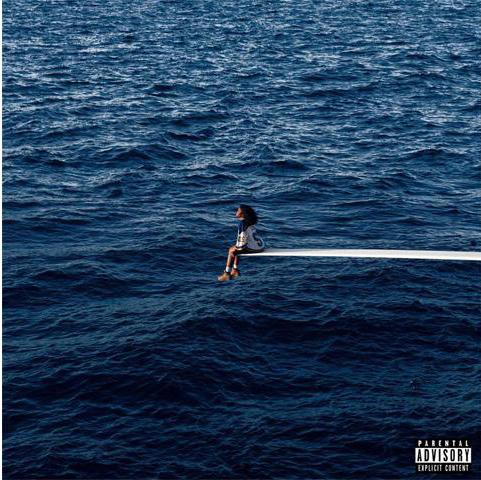
Tasty
savage vengeance against self-serving men and record executives, most notably on the belligerent interlude “Smoking on My Ex Pack.” But, once the empowerment of anger naturally subsides, it’s the perpetual hurt, distrust, and loneliness that lingers on her tongue. “Ghost in the Machine,” featuring a beautiful integration of Phoebe Bridgers and her narrative style, reveals her desperation for empathy and graciousness following her realization that she is a cog in the much grander machine of fame and the industry. The pleads in lyrics like “I need humanity / Y’all lack humanity, drowning in vanity” are transparent. SZA, not unlike Princess Diana, is trapped in an opportunistic institution with little regard for women’s well-being.
SZA is markedly different from her contemporaries. She is publicly struggling, repeatedly vocalizing how the pressure of following up her monumental first album, CTRL, was crushing and flirting with the idea of retirement. Her imperfections aren’t delivered in endearing doses by PR managers, but rather Twitter diatribes and overly raw interviews — and SOS is her getaway car from
the chaos. SZA has undisputedly created a technically impressive, generously vulnerable body of work. The album possesses a consistently plush yet eclectic sound which allows a pop punk ballad like “F2F” to make perfect sense sandwiched between fantasies of first degree murder and braggadocious raps. Reluctantly climbing atop the judgment chair, she dishes her shame and imperfections with glimmering trust. In return, her fans, as her confidants, will savor this until the next magnum opus.
10 7 3 9 6 2 8 4 5 1
Ananya Chaudhari (Economics and Business)
Spring 2023 Reviews 50
Måneskin RUSH!
Released January 20, 2023
Label Sony Music Enterntainment Genre Rock
Tasty Tracks “DON’T WANNA SLEEP,” “READ YOUR DIARY,” “IL DONO DELLA VITA”
After winning Eurovision on behalf of their home country Italy in 2021, Måneskin’s popularity within the rock and roll sphere skyrocketed, bringing glam rock back into the spotlight with infectious riffs and a flashy stage presence. Riding off this high, RUSH!, the band’s fourth studio album, diversifies their appeal as a band while still holding their distinct fiery sound close in this ambitious project. However, the band flew too close to the sun in RUSH! trying to do this.
In their earlier albums, Måneskin maintained a delicate balance, oscillating between a fast-paced, gritty sound and a melodic, heartfelt one. They attempt to continue this on RUSH!, with the steady and bass-driven, yet energetic, “OWN MY MIND”, but their attempt falls flat and their previous
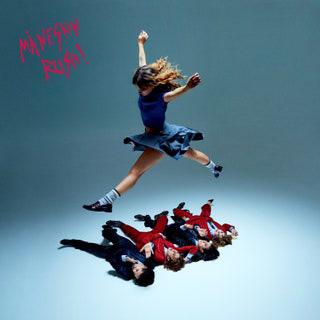
duality comes across as inconsistent as they try to appeal to the wide variety in audience they’ve gained from their newfound fame. On “TIMEZONE,” the band abruptly shifts into a sincere melody about how lead singer Damiano would fly anywhere to be with his lover. This introduces inconsistency on the album, especially as it is followed by the punky “BLA BLA BLA,” where Damiano details a disastrous rebound after a breakup featuring drugs, crashing cars, and repeated jabs at his ex. In effect, this unpredictableness doesn’t allow for the band to develop either theme as it switches so frequently between them.
Further into the album, however, Måneskin treads on with their catchy, fastpaced melodies. “DON’T WANNA SLEEP” best characterizes their sound with its driving beat and snappy melody disguising the melancholic topic of loneliness; this contrast represents how the band uses partying to distract themselves from the isolation they face as a byproduct of their fame. During their rise to rock stardom, the theme of loneliness rings genuine to the band members while simultaneously providing a strong foundation to relate to the wide array of fans they’ve accumulated while enticing new fans with the driving instrumentals. Continuing this fast, carefree tone in the album is “READ YOUR DIARY.” Creatively characterizing Damiano’s obsession with a crush, this exhilarating track beautifully showcases Damiano’s vocals atop a lively guitar solo. The lyrics are especially notable, detailing the extent of Damiano’s obsession as he tells his crush he “cried on your nudes, wearing your perfume” and “was dancing in your shoes when I read your diary.” These unapologetic lyrics are a cornerstone of Måneskin’s lyrical development through their discography and well-represents the
band’s musical proposition of delivering music that is daring yet profound. This dynamic was best illustrated in “READ YOUR DIARY.”
Alongside the inconsistency of the album lies the half-baked themes the album fails to develop on. The theme of loneliness is a prominent theme in the album, but it never gets fully fleshed out due to the variance in tracks throughout the album. “READ YOUR DIARY” and “TIMEZONE” are absorbed in loneliness, but “BLA BLA BLA” insinuates that Damiano is better off without a partner. Other songs in the album hardly develop on this theme, and opt for different focuses. “IL DONO DELLA VITA”, for example, chooses to focus on the feeling of accomplishment and satisfaction after finishing a task you’ve strived to complete. However, barely relating to loneliness, this only adds another underdeveloped theme to the project, which is hardly explored on other tracks.
RUSH! as a whole features songs of different styles to appeal to a wide audience. But, in an attempt to please all, Måneskin sacrifices a consistent and cohesive album as they struggle to choose between songs that are either catchy and exciting or heartfelt and personal. Måneskin has never been a band to follow rules, and they keep it that way on RUSH!, barely managing to satisfy long-time fans while leaving new fans confused as to what’s next.
Justin Guthrie (Business Administration and Data Science)
10 7 3 9 6 2 8 4 5 1 Edible 51
Let’s Start Here. Lil Yachty
Released January 27, 2023
Label UMG Recordings
Genre Space Rock, Neo-Soul Tasty Tracks “the BLACK seminole.,” “drive ME crazy!,” “running out of time”
Lil Yachty’s newest release is exactly what its name suggests: a fresh start — and an extreme one at that. There’s a sense of disbelief hearing the guy who made “Minnesota” and “Poland” suddenly veer into Pink Floyd-inspired psychedelia, but this is exactly what the Atlanta native wanted. From pre-release quotes, it’s apparent Yachty desires external validation, and to achieve that, he’s radically altered his style. The idea that artists in his lane need to reach beyond trap and jump genres to garner artistic respect is, unfortunately, not a new one. No matter how much the boom of internet culture has widened its accessibility, general snobbery surrounding popular music prevails, and in the eyes of many, his songs — as catchy and fun as they may be — could never
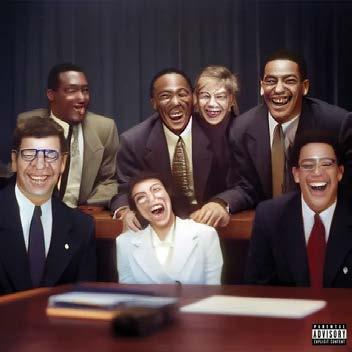
be considered substantial pieces of art. With this in mind, it’d be easy to assume that this new album is Yachty’s desperate, possibly hollow attempt to establish legitimacy, but this apprehension melts away when you give the album a listen. Let’s Start Here. is an immensely ambitious project that executes on its vision more often than not, giving Lil Yachty a new canvas to play with and highlighting his strengths as a vocalist. Even after the novel shine of this guy dropping this album wears off, a cohesive and thoughtfully crafted project remains underneath.
Yachty’s influences are apparent — made obvious by the many samples and interpolations from The Dark Side Of The Moon. At large, the sound of the record isn’t particularly cutting edge, but it builds an immersively spacey, everchanging atmosphere to get lost in. “the BLACK seminole.” hurls the listener into a kaleidoscope of cycling synths, flanged guitars, and the autotune-soaked vocals of Lil Yachty. It’s a wondrous opening track with a stunning instrumental switch-up that immediately forecasts the rest of the album: an emphasis on unpredictable and lavish instrumental progressions rather than hooks and melody. Almost every song pulls out some grand trick, from distorted guitar solos to monstrously massive instrumental outros like on closer “REACH THE SUNSHINE.” Though these spots start to feel repetitive as the album progresses, the production is so stellar that it almost masks this flaw and keeps repeat listens enjoyable.
The album’s sonic palette lays immaculate groundwork for Yachty’s journey of rediscovery. More than just a fresh start to his music career, Let’s Start Here.showcases his rejuvenation as an individual. Several tracks detail his struggles grappling with success and feelings of loneliness, most
apparent on “THE zone~.” The interlude “:(failure(:,” though a bit corny, clearly expressing his growth in perspective as he continues to navigate the whirlwind of fame at a young age. Even on the many songs about sex, his songwriting has matured tremendously. The infectious “drive ME crazy!,” for instance, begins as a sensual duet between Yachty and Diana Gordon before taking an introspective turn into how sex is a vice for him.
The hardest sell for someone who hasn’t been a fan of his past work will be the vocals. There’s a juvenile quality to his voice, and oftentimes his lyrics, which people have either lauded or intensely ridiculed. His heavily autotuned voice hasn’t changed on Let’s Start Here., but with a more luscious backdrop to play with, Yachty leans heavily into his vocal oddities and employs his voice as an instrument. His quivering timbre and high register add yet another texture to the psychedelic wash of the album. He doesn’t just blend in the background, though, a lot of the album sees him front and center. On “running out of time,” Yachty cuts through the bass and trumpets with palpable confidence, and on “the ride~” he glides atop a shimmering instrumental with ease. There are a few songs that would be better served by a stronger vocalist, but throughout the majority of the album, Yachty’s voice is a key factor in enhancing its aura.
The outside negativity that helped brew Let’s Start Here. could’ve led to an uninspired, last-ditch effort from Lil Yachty to overhaul his image. Instead, he proves his versatility as an artist like never before, and has opened up the door for more adventurous works going forward. He pulls off one of the most sudden artistic shifts in recent memory, and shows that this new direction may be a wild change of pace, but it’s certainly not a gimmick.
Henry Bova (Journalism)
10 7 3 9 6 2 8 4 5 1 Fresh Spring 2023 Reviews 52
Samia Honey
Released January 27, 2023
Label Grand Jury Music
Genre Indie Pop
Tasty Tracks “Charm You,” “Breathing Song,” “Dream Song”
CW: mention of sexual assault
If singer-songwriter Samia’s debut
The Baby was her admission of fearing confrontation and abandonment, Honey is a strong statement that she didn’t ignore her anxieties, she embraced them. Despite all the pain it brought, one thing’s clear — the growth that resulted made the grief she experienced more than worth it.
Sonically, her artistic maturation in the last three years is on full display. In comparison to The Baby’s frantic indie-rock sound, Honey is consistently soft around the edges while exploring enough genres and textures to stay interesting. Her use of sparseness and silence throughout is smart, with tracks like “Pink Balloon” and “Breathing Song” keeping production minimal to let the story remain the focus. “Mad at Me,” one of her most heavily pop-leaning songs yet, veers in the opposite direction with a four-on-thefloor beat that stands out amidst a generally mellow album. Despite this difference, it’s lyrically warm and candid enough to feel like an intentional placement.
Though her sound has certainly moved in a new direction, her lyricism is as potent as ever — even as her cryptic songwriting has shifted towards more earnest topics.

“Kill Her Freak Out” picks up where The Baby left off. It’s an explosion of profoundly repressed feelings and violent thoughts, but she doesn’t linger on resentment long — the remaining 10 songs are full of sage reflection and her being honest with herself in many ways. “Charm You” is a sweet but firm country-tinged assertion that she’s not looking to get tangled up with anybody, and the title track finds her mocking her inclination to use alcohol as a selfconfidence boost and the validation seeking that follows. Throughout these vignettes, she continues her trend of embedding herself in her work by way of name-dropping details, from a favorite music venue to her closest collaborators and even including family, with a voicemail from her late sittoo (grandmother) closing out “To Me It Was.” Her specificity can feel somewhat random when she’s introducing new parts of her universe, but her sincerity makes even the oddest detail fit and feel important.
Alongside the wisdom that Honey imparts, she also uses it as a vessel for processing some of her more difficult experiences. “Breathing Song,” selfdescribed upon its release as the “scariest thing” she has ever shared, uses painful detail to work through the aftermath of experiencing sexual assault. As she walks through an ER visit, retelling the experience to a friend, and more, her vulnerability is arresting, and the self-doubt that runs through it makes it land that much harder. Though the strife she explores packs a punch, she makes sure not to let it have the last word; closer “Dream Song,” exhibiting some of her most vivid storytelling yet, provides a moment of clarity after a barrage of pensive recollections. With lines touching on continuous healing (“Swimming to the other side / Someday, I’m gonna when I finally forgive myself”) and finding trust after instability and trauma (“Ferris wheel, sun in the sky / I believe you and I know why”),
every lyric is an affirmation for herself, a reminder that, beyond the pain it can cause, introspection can yield her brightest moments.
Listening through Honey feels like hearing stories from an older sister, one who’s fought to find security and wants you to know how to find it yourself. With only two albums under her belt, Samia’s uniquely warm presence in indie-pop continues to be a promising force; if just three years is what it took to bring about Honey, then there’s good reason to look forward eagerly to what her next project will bring.
Karl Adrianza (ASL and Psychology)
10 7 3 9 6 2 8 4 5 1 Fresh
53
CROSSWORD (Colors Edition)
ACROSS
2. TV Girl, Mac Miller, boygenius and Lana Del Rey all have a song title with this color in it






7. The Frank Ocean album which features “Super Rich Kids”
8. A song by girl in red: “we fell in love in ___”
10. The color of the fruits featured in the names of two Harry Styles songs
DOWN
1. This song by Metric was featured in Scott Pilgrim vs the World
3. The first track on Taylor Swift’s Midnights
4. Hole, Bad Suns, and Hippo Campus all have songs named this color
5. This album by My Chemical Romance was released in 2006: Welcome to the ____ Parade
6. North Carolina rock band named ____ Kitten Surprise
9. Black Pumas have a song named after this crossword

Across: 2. Blue 7. Channel Orange 8. October 10. Red Down: 1. Black Sheep 3. Lavender Haze 4. Violet 5. Black 6. Rainbow 9. Colors ZOOMED Can you tell which
we’ve zoomed in on? 1st Row: SOS - SZA Nevermind - Nirvana Oil of Every Pearl’s Un-insides - SOPHIE 2nd Row: Montero - Lil Nas X Andromeda - Weyes Blood Californication - Red Hot Chili Peppers
six album covers
FIND RIHANNA
We’ve hidden Rihanna somewhere in this issue. Find her and maybe something cool will happen...

FOLLOW US
Like what you read? Check us out online.
tastemakersmag.com
@tastemakersmag

LOCAL PHOTO
Future, TD Garden
Photo by Emily Gringorten (Computer Science)









 Modest Mouse, Terminal 5
Photo by Nick Alonzo (Architecture)
Modest Mouse, Terminal 5
Photo by Nick Alonzo (Architecture)





























 Designer: Laura Mattingly (Communications & Design)
Designer: Laura Mattingly (Communications & Design)








 • Lacie Foreht (Communication & Media Screen Studies)
• Lacie Foreht (Communication & Media Screen Studies)













 Suki Waterhouse, Paradise Rock Club
Photo by Mukki Gill (Mechanical Engineering and History)
Suki Waterhouse, Paradise Rock Club
Photo by Mukki Gill (Mechanical Engineering and History)

 MAX, Royale
Photo by Emily Zakrzewski (Civil Engineering)
Emlyn, Sonia
Photo by Matt Rose (Communications and Media and Screen Studies)
MAX, Royale
Photo by Emily Zakrzewski (Civil Engineering)
Emlyn, Sonia
Photo by Matt Rose (Communications and Media and Screen Studies)
 Zoe Sparks, The Red Room
Photo by Anna Kelly (Health Science)
Zoe Sparks, The Red Room
Photo by Anna Kelly (Health Science)
 almost monday, The Sinclair
Photo by Helen Cai (Health Science and Business Administration)
almost monday, The Sinclair
Photo by Helen Cai (Health Science and Business Administration)












 • Jessica Gwardschaladse (History, Culture, and Law)
• Jessica Gwardschaladse (History, Culture, and Law)



 • Rilyn Szabo (Behavioral Neuroscience)
• Rilyn Szabo (Behavioral Neuroscience)
 Stephen Sanchez, Brighton Music Hall
Photo by Alder Whiteford (Computer Science and Business Administration)
Stephen Sanchez, Brighton Music Hall
Photo by Alder Whiteford (Computer Science and Business Administration)



















